If you love backpacking, set out on the ultimate Isle Royale backpacking adventure, immersing yourself in one of America’s most secluded national parks with over 165 miles (256 km)of trails. As a remote island wilderness nestled in the heart of Lake Superior, this rugged wilderness offers a serene haven for hikers eager to explore its unique ecosystem.
Whether you’re meticulously planning your route, pondering the right gear to pack, or envisioning nights under the stars at your chosen campsite, Isle Royale’s untamed beauty is calling. So sharpen your sense of wanderlust as we guide you through catching a glimpse of majestic wildlife and honoring the cherished Leave No Trace principles.
In this article, we’ll cover how to plan your Isle Royale backpacking trip, how to get to and from Isle Royale with backpacking gear, the backcountry permits process and help you pick the right backpacking gear for your wilderness visit. Not sure where exactly to backpack? Have no fear – we’ve provided several Isle Royale backpacking itineraries for some of the best overnight trips you can take on this remote island paradise.
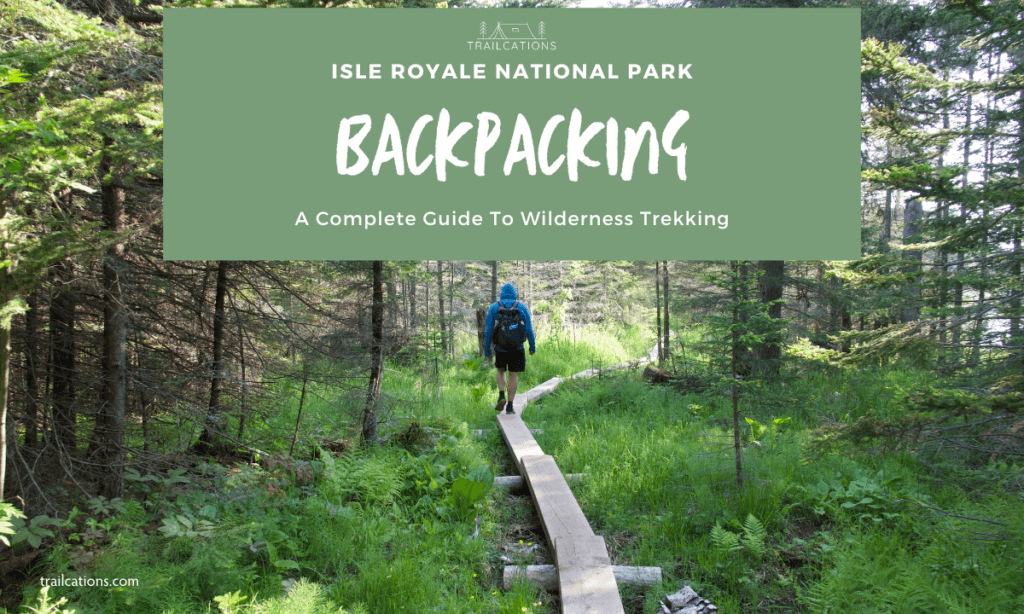
- Key Takeaways
- Why Should I Consider Backpacking on Isle Royale?
- Planning Your Isle Royale Backpacking Trip
- Understanding Isle Royale's Unique Ecosystem
- Best Time of Year to Visit Isle Royale
- Camping Options on Isle Royale
- What to Pack for Your Wilderness Adventure
- Getting to Isle Royale National Park
- Backpacking Isle Royale Maps
- 9 Best Isle Royale Backpacking Itineraries
- Arriving at Camp and Campsite Etiquette
- Water Sources and Food Storage Tips
- Wildlife Watching on the Island
- Leave No Trace Principles at Isle Royale
- Isle Royale Overnight Camping Permit Process and Fees
- Staying Safe While Backpacking in Remote Wilderness
- FAQs
Key Takeaways
Isle Royale should be on your backpacking bucket list with its incredibly beautiful, rugged, remote north woods wilderness and up close encounters with wildlife like moose, beavers, loons and wolves. There are tons of truly stunning backcountry campsites and trails for backpacking, from easy walks to challenging hikes, but you must be completely self-reliant due to remote terrain and plan your trip early since you can only access Isle Royale by ferry boat or seaplane.
Why Should I Consider Backpacking on Isle Royale?
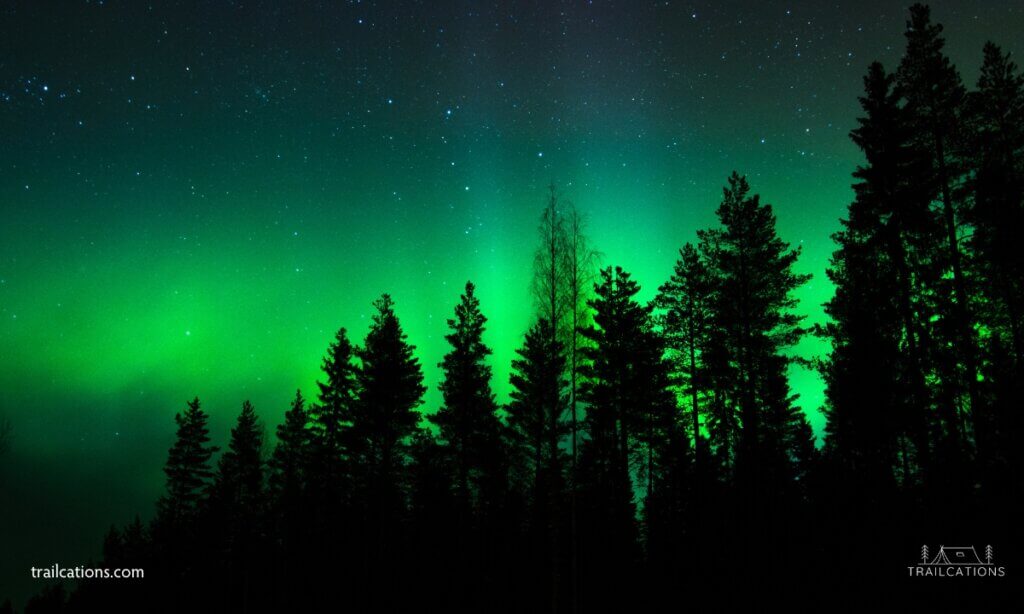
Backpacking in Isle Royale offers a unique and rewarding experience due to the island’s remote and peaceful wilderness. The park provides well-marked trails, exciting wildlife viewing opportunities, excellent stargazing and northern lights viewing, as well as beautiful lake sunrises and sunsets.
Isle Royale offers diverse challenging terrain, beautiful vistas and a remote experience due to its lack of cell service anywhere on the island. It is also an adventure simply reaching Isle Royale which is an island in Lake Superior 14 miles (22 km) from the nearest mainland via ferry or seaplane.
Additionally, every one of the island’s 36 campgrounds has outhouses, water sources. Many of the campgrounds also have picnic tables, overflow campsites, fire pits and spacious screened huts that keep backpackers safe from the mosquitoes and biting flies. The island’s “least visited national park in the lower 48 states” status means that wildlife abounds, offering the chance to spot animals like moose, loons, wolves and otters right at camp.
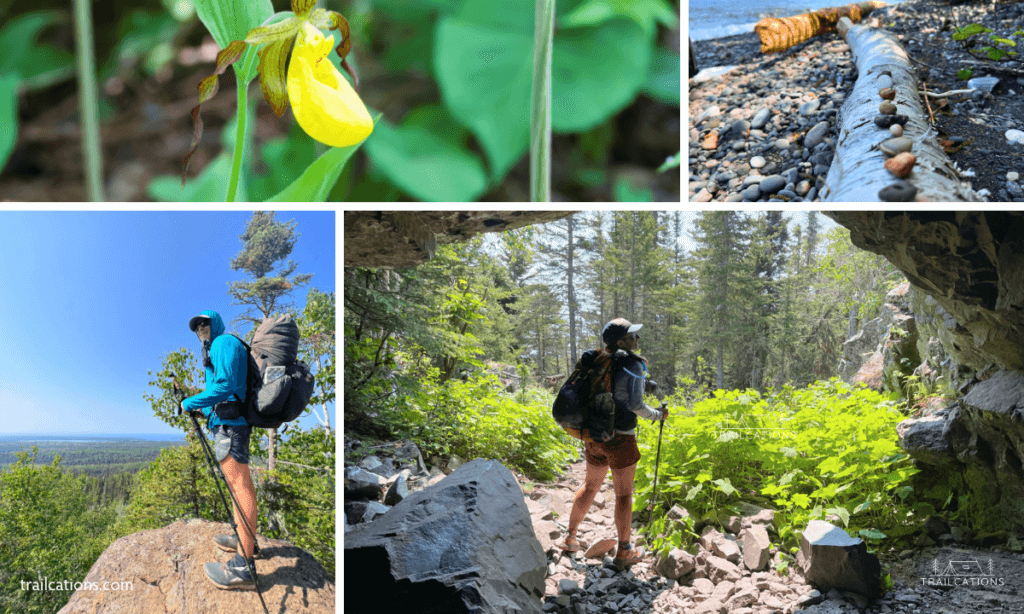
Backpacking Isle Royale for Beginners and Advanced Hikers
Backpacking in Isle Royale is also a great option for beginner backpackers due to the variety of well-marked trails and the availability of amenities at the campgrounds such as water sources, swimming beaches and fire pits. The island’s designated wilderness area ensures a unique and tranquil experience for all visitors.
Advanced backpackers can challenge themselves to the Greenstone Challenge, traversing the entire 45 mile (73 km) length of the island along the vistas of Greenstone Ridge. Really crazy hikers can circumnavigate the entire island, sampling a bit of everything in this 94 to 115 mile (151 – 185 km) adventure.
Did You Know? Isle Royale National Park may be one of the least visited US National Parks but it happens to be the most revisited of all national parks. It’s kind of like a secret club – no one really knows about Isle Royale but the ones who do come back time and time again!
Planning Your Isle Royale Backpacking Trip
One of the critical aspects of a successful Isle Royale backpacking trip is meticulous preparation. Start planning at least 2 to 3 months in advance as this remote location is only reachable by ferry boat or seaplane which often sell out many months in advance. Check out our Trailcations guide for first-time Isle Royale National Park visitors.
Itineraries could range from a weeklong backpack journey, where you can enjoy tasty dehydrated meals while basking in the serene ambiance besides lakes inhabited by loons, to shorter two-day or three-day trips.
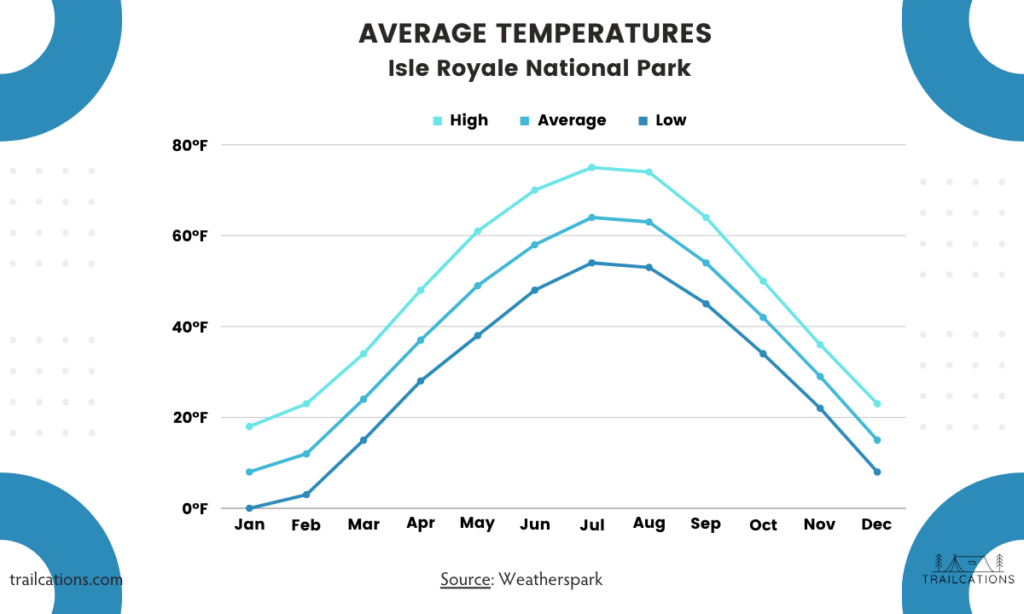
Step 1: Choose When to Go to Isle Royale National Park.
Typically the best time to backpack Isle Royale is in June, July, August due to the pleasant weather conditions and the ferries/seaplanes are operating at full schedule. May is cooler and offers lots of baby animal sightings whereas September and October are spectacular for fall colors and moose become more active during rut season.
If you’re looking to avoid the crowds, opt for the shoulder seasons of May, early June or September. However, it can be tricky to reach the island in the shoulder seasons as the ferries and seaplanes typically only operate mid-May through mid-September.
Isle Royale is only open to the public April 16 to October 31. Outside this time, the harsh winter conditions on this remote north woods island make it too dangerous to operate ferries or seaplanes. Icebergs, pack ice, blizzards, huge waves and ice storms provide dangerous or deadly obstacles that have claimed many ships and lives in Lake Superior.
Learn more about Isle Royale National Park weather here.
Step 2: Pick Your Backpacking Trip Itinerary
Isle Royale is surprisingly hilly and can be technically challenging with roots, rocks, swamp crossings on narrow boardwalks, bushwhacking through flooded beaver trails and dry, hot exposed ridge walks.
Choose your backpacking trip with your fitness and experience level in mind. You will need to be entirely self-sufficient on Isle Royale as there are limited supplies and ranger resources on the island.
No Cell Service or Wifi on Isle Royale
There is absolutely ZERO cell service on the entire 45-mile-long (72 km) island. Trails are extremely rugged and there are no roads. Rangers warn every visitor that a backcountry rescue may take many hours or even days due to limited resources and inaccessibility of the terrain. Make sure to take a Personal Locator Beacon (PLB) or satellite messenger in case of emergencies.
What is the Terrain Like on Isle Royale?
We found that the rocky terrain is similar in difficulty of the nearby northern sections of the Superior Hiking Trail in Minnesota. It is also similar to parts of the Appalachian Trail with its pointless-ups-and-downs (PUDs) – think the Vermont, New York, Connecticut or Virginia sections.
Pro Tip: Even if you’re strong hiker, give yourself some extra time on Isle Royale to actually enjoy the beauty of the place. Almost everyone we met mentioned how they wished they had more time on the island.
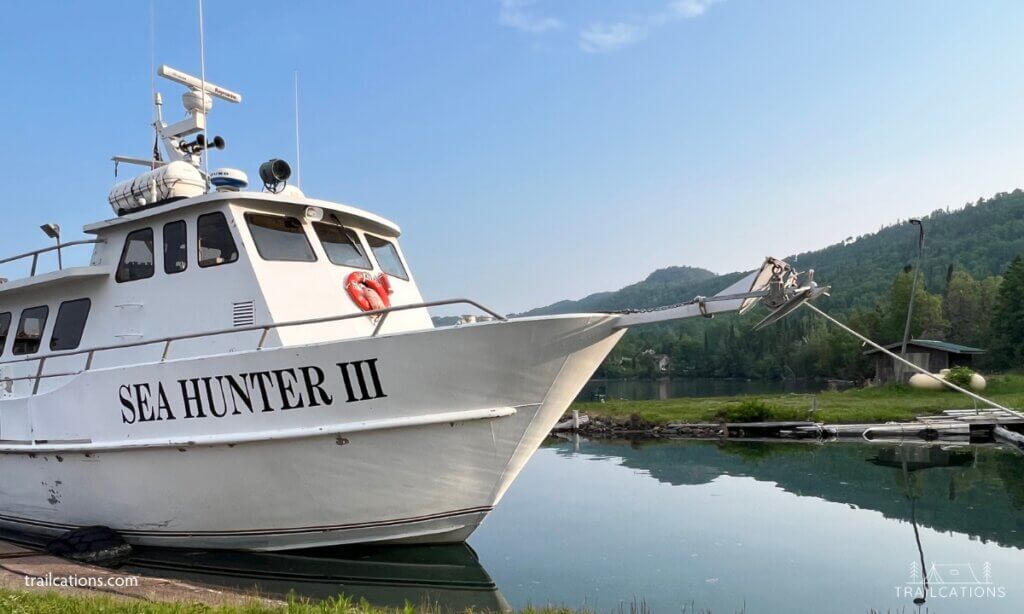
Step 3: Reserve your spot on the Isle Royale ferry or seaplane.
You may need to be flexible as the ferry and seaplane services can sell out months in advance. Book both your trip to and from Isle Royale at this time. Do NOT wait to book your return trip.
Access to Isle Royale National Park is not limited by reservations or entry lotteries. Instead, access to Isle Royale is entirely dependent on whether or not you can reserve a ferry or seaplane spot. The ferry and seaplanes often sell out completely 2 to 3 months during the summer.
Cars are not allowed on Isle Royale – instead you leave your car on the mainland and take a ferry or seaplane. Physically you cannot drive to the island as it is located 14 mi (22 km) in Lake Superior from the nearest mainland. Learn how to get to and from Isle Royale here.
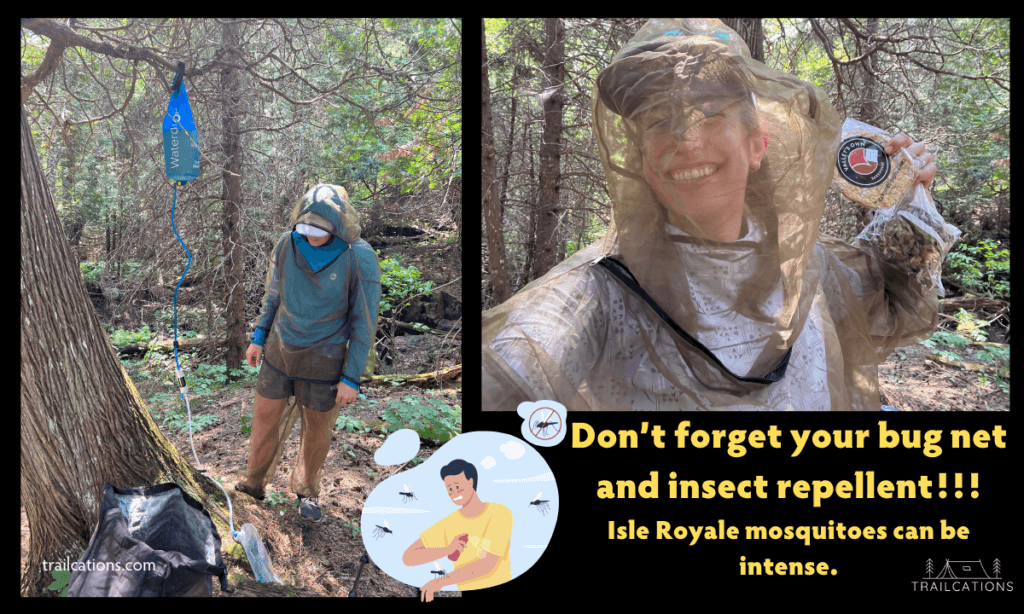
Step 4: Prep and Pack
Training for Isle Royale
Because of its remote rugged terrain, backpackers should be in fairly reasonable shape before setting foot in the Isle Royale backcountry. Make sure you train by doing both cardio and strength training as those ups and downs on the ridges are certainly a leg workout!
Pack Extra Supplies in Case You Get Stuck on Isle Royale
Pack enough food, medicines and supplies to last you your entire trip and then pack an extra day or two of supplies. It is uncommon (but happens every season) that if bad weather comes up, the ferry or seaplanes won’t be able to make the Lake Superior crossing. You may be stuck on the island another day or so.
Don’t Forget Bug Spray (and a Head Net)
Finally, I cannot stress this enough: bring extra strength 100% DEET or 20% Picardin insect repellent AND an insect head net or full bug suit. Especially in May-July, the mosquitoes and biting flies on Isle Royale are unlike anything you’ve probably ever experienced. Organic or all-natural bug spray does NOT work on Isle Royale’s mosquitoes – they are freaks of nature and have evolved to suck you dry.
We were hiking 4 mph (6.5 kph) and still getting bit with blood streaming off our faces, staining our clothes and having to wear full bug suits to filter water or eat a snack. Be in your tent or screened in shelter once the sun goes down or you might go a little crazy.
Pro Tip: Campsites facing Lake Superior tend to have less mosquitoes due to the breezes and cool air. The campgrounds in the forest or interior lakes often have the worst mosquitoes.
Step 5: Permitting and Entry Fees
Permits are required regardless of group size for any overnight stay at campgrounds across the island. Day hikers do not need backcountry permits.
Everyone over the age of 16 must pay a National Park Service daily entrance fee. It’s recommended to pay in advance online or bring a credit card to pay upon arrival as the NPS does not accept cash anymore.
If your total is more than $60 in entrance fees, it is recommended to purchase the Isle Royale Season Pass to save money.
Backcountry Permits for Small Groups (6 or Less)
Backpacking permits are free of charge for groups of 6 or less. Currently you cannot reserve your backpacking permit but honestly you don’t have to worry about not getting one. With visitor numbers limited by the ferries and seaplanes, there are no lotteries or reservation systems required.
Instead, the rangers take you through a fairly casual permitting process either aboard the ferry or upon arriving on the island. Itineraries are not enforced for small groups so if plans change, you can still easily find a campsite. There is no competition – you can be last in line and will still get the same permits as the first in line person.
Bring a rough itinerary of your backpacking and camping plans to speed up the permitting process. You will need to keep your permit on your tent or backpack at all times.
Don’t forget to check out with the rangers at the Windigo or Rock Harbor visitor center when you leave! The permits are more to keep track of who is in the wilderness and collect data on campsite usage.
Backcountry Permits for Large Groups (7 to 20)
However, large groups of 7 to 20 people must reserve their camping permits in advance for a fee. These numbers include the trip leaders. Keep in mind that if you show up to the island without a backcountry large group permit, you will be immediately asked to leave and possibly fined.
Some Isle Royale campsites are too small to accommodate large groups. Since 99% of the island is wilderness, there are also special restrictions about group travel and you may need to break up your group while hiking. Find out more on the backcountry large group permit site.

Understanding Isle Royale’s Unique Ecosystem
So, you still think you want to go to Isle Royale to backpack? Heck yeah – let’s do it!
Situated in Michigan’s Lake Superior, the isolated wilderness of Isle Royale National Park presents a unique north woods ecosystem teeming with wildlife encounters such as moose, wolves, loons and foxes. Nature enthusiasts find the park particularly exciting due to its diverse flora and fauna, rugged landscapes and its world-famous Predator-Prey study.
Also known for its spectacular greenstone ridges stretching across the island’s backbone, the park offers stunning views of a landscape of shimmering lakes and thick forests. Due to lack of hunting, wolves and moose regularly visit campgrounds and can be sometimes spotted even by the ferry docks.
Isle Royale: 99% Wilderness, 0% Cell Service
Due to harsh Lake Superior conditions, Isle Royale is the only US National Park to close in the winter. Icebergs, pack ice, huge waves, blizzards and ice storms batter the island in the winter making it much too dangerous to access.
In fact, many of the resident mammals on the island, including the moose and wolves, crossed a 15 to 20 mile (24 to 32 km) ice bridge that occasionally forms in winter, connecting the mainland of Minnesota and Ontario to the island.
Isle Royale’s ecosystem is fragile yet robust, and preserving it requires responsible human behavior, especially regarding camping practices and wildlife encounters. 99% of the park is federal wilderness. The areas of Rock Harbor and Windigo rely entirely on regular boat shipments for food and supplies, as well as diesel generators and solar panels for energy.
There is no cell service or public wifi on the island. If you stay at the Rock Harbor Lodge, guests can access wifi in the lobby but not the rooms.
Respect the park’s integrity by adhering to the “Leave No Trace” principles when navigating through this majestic wilderness. Remember, our role is not to disturb but appreciate this stunning natural spectacle.
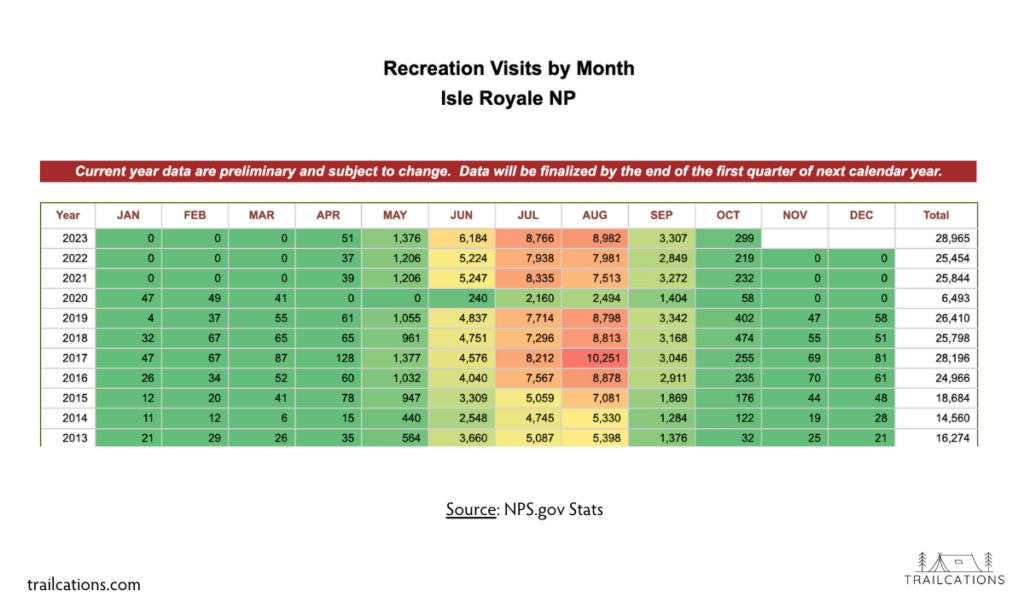
Best Time of Year to Visit Isle Royale
Isle Royale National Park is a haven for hikers, backpackers, and wilderness lovers, attracting visitors throughout its open season from April 16th to October 31st. The best time to visit is sort of subjective – each month on Isle Royale offers pros and cons.
Most Popular Time of Year to Visit Isle Royale
According to National Park Service stats, the most popular months to visit Isle Royale National Park are June, July and August. Ferry and seaplane service is operating at full capacity and island amenities like the restaurants, lodging and general stores are open full time. However, campgrounds can get crowded during these months, especially the more popular sites near Rock Harbor and Windigo.
Best Months to Avoid Mosquitoes on Isle Royale
Typically, the best months to avoid bugs on Isle Royale would be May, early June, late August and September. Typically mosquitoes and biting flies hatch in full force about mid-June to July and only start dying off with cooler temperatures in late August.
If it’s a wet summer, however, you might be fighting an insane amount of bugs all season. Check the Isle Royale Bug Report before you go to understand if bug spray is good enough or if you will need a head net or full bug suit.
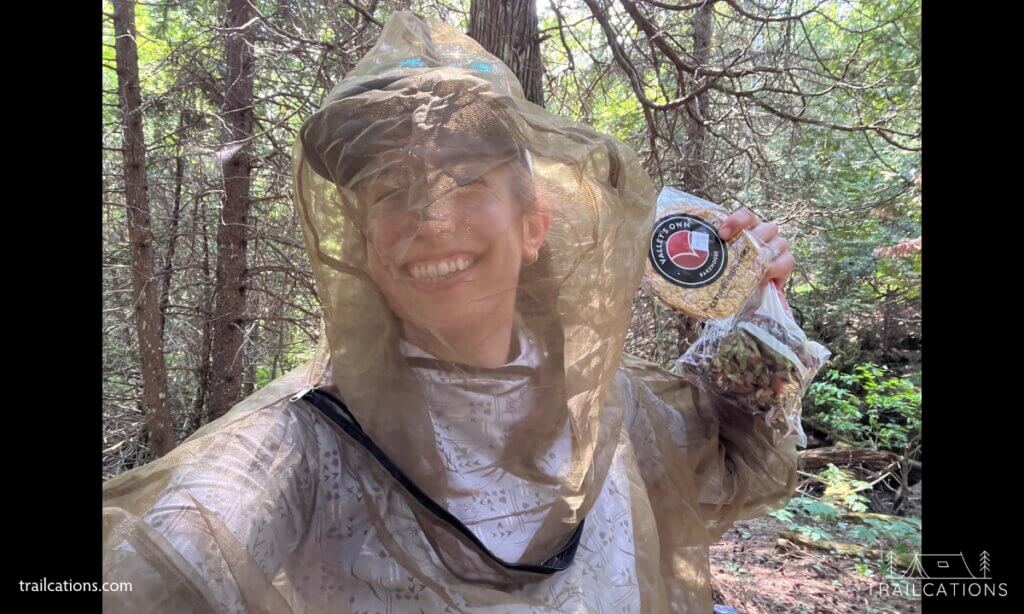
Best Time To Backpack Isle Royale
The best time to backpack Isle Royale is typically in June, July, August due to the pleasant weather conditions. May is cooler and offers lots of baby animal sightings whereas September and October are spectacular for fall colors and moose become more active during rut season.
By month, here is what backpacking looks like on Isle Royale.
- January – Isle Royale is closed to the public due to dangerous winter conditions.
- February – Isle Royale is closed.
- March – Isle Royale is closed.
- April – Park is closed to public until mid-April due to lake ice. Still very snowy, icy and only the park maintenance staff typically come during this time. No ferries, seaplanes or lodging but camping is available.
- May – Can be late winter conditions, flooded or muddy. Ferries don’t run until mid-May. Lodging and other amenities like restaurants and general stores are still closed. No crowds.
- June – Mosquitoes and biting flies usually arrive in hoards as the days warm up. Baby animals and wildflowers abound. Lodging, restaurants and stores open up early in the month. Ferries and seaplanes operating full schedules and start to sell out.
- July – Typically peak visitor month. Ferries and seaplanes sell out months in advance, lodging is booked up. Campsites can become crowded. Wildflowers and beautiful north woods conditions. Berry season. Backcountry water sources can become tainted with algal blooms that cannot be filtered or treated.
- August – Another peak visitor month with sold out ferries and seaplanes. Campsites fill early. Mosquitoes and flies start to die off. Backcountry water sources can become tainted with algal blooms that cannot be filtered or treated. Cooler temperatures towards the end of the month.
- September – Visitors taper off. Beautiful fall colors and hiking weather. Ferries and seaplanes stop running mid- to late September. Lodging, restaurants and stores reduce services. Campsites are not crowded.
- October – No ferry or seaplane services. Lodging, restaurants and stores close down. Park staff starts leaving and closing up for winter.
- November – Isle Royale is closed.
- December – Isle Royale is closed.
Still not sure when the best time to visit Isle Royale is? Our in-depth guide weighing the pros and cons of When to Visit Isle Royale by month is sure to help you make the right decision.
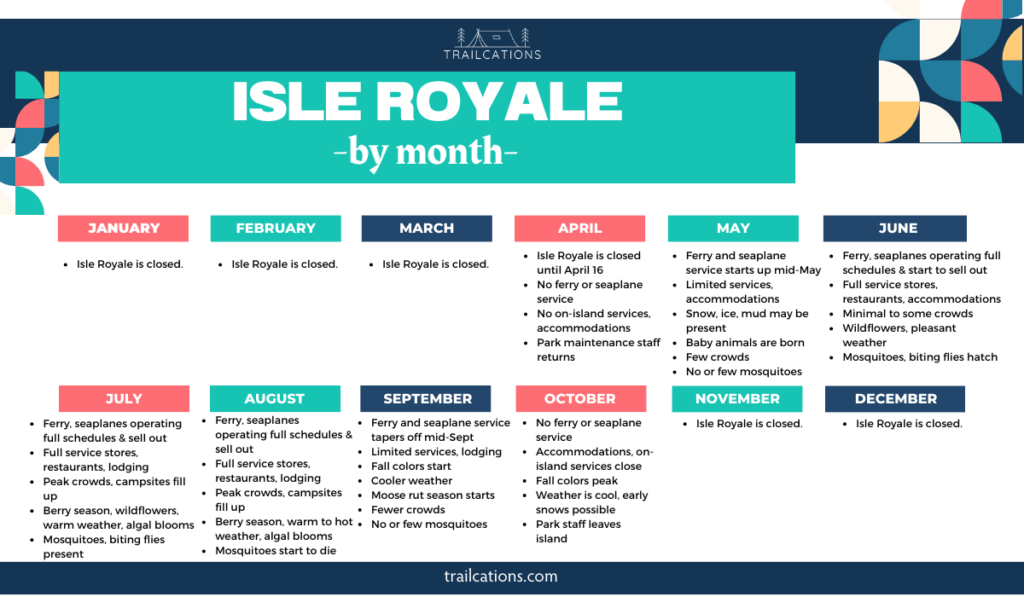
Camping Options on Isle Royale
The park offers an incredible 36 campgrounds across the island which are only accessible by foot or watercraft – an aspect that accentuates Isle Royale’s remote allure. Each campground is very well marked with a map at the entrance trail and each provides tent sites, a pit toilet and a water source.
Among them are the Daisy Farm Campground, a stunning lakeside camp that offers shelter for hikers who’ve conquered the trail from Rock Harbor. Another campground worth considering is Todd Harbor or Feldtmann Loop Camp with nearby beaches making it a great spot for camping amidst nature’s beauty.
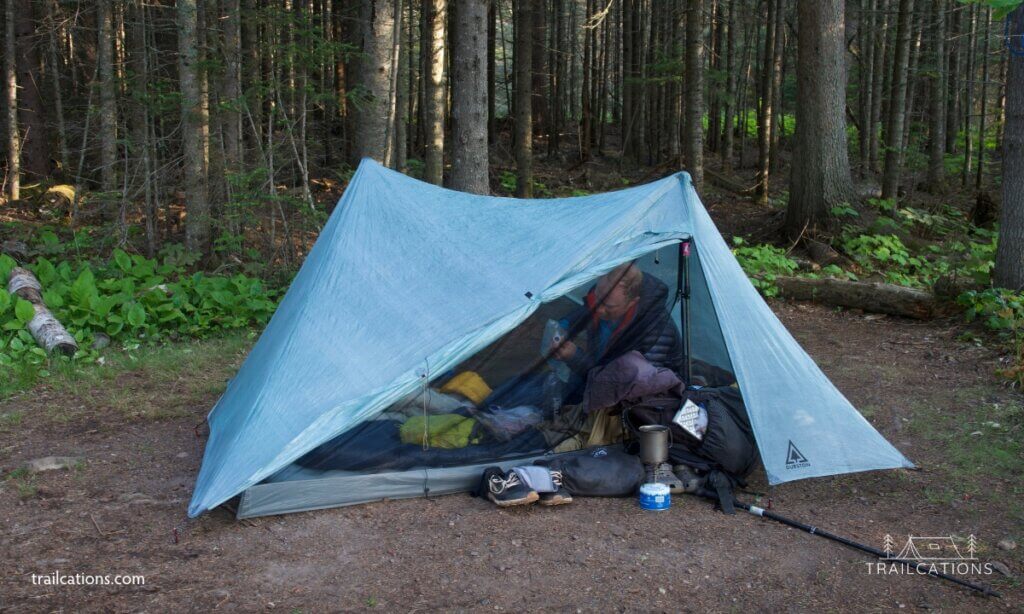
Selecting a Campsite
Some of the more popular campsites have screened-in four sided shelters that are also available on a first-come, first-serve basis. All campsites are first-come, first-serve
Given that these campgrounds lie in wilderness zones, remember Leave No Trace guidelines related to food storage and waste disposal.
What to Pack for Your Wilderness Adventure
Packing for your Isle Royale backpacking adventure takes on additional importance as you’ll often be in remote locations with no cell service and dealing with rugged terrain. It’s important to pack everything you need to be completely self-sufficient.
Ensure you have a sturdy pair of hiking boots or shoes, given the island’s rugged terrain. Hiking poles help as you will likely find yourself bushwhacking in some areas where beavers have built dams and flooded the trails, or where the park’s limited trail maintenance staff hasn’t yet reached.
Also, ensure your backpack contains all necessary items including enough high-energy food, 2 to 3 liters water capacity, electrolytes (it can get really hot on the ridges), a water purifier, camping gear like tents and sleeping bags as well as clothing suited for variable weather conditions, especially the sun.
Make sure to download your offline navigation apps and have a compass and map of Isle Royale National Park handy.
Always bring a first aid kit. Remember to pack based on the number of days you intend on staying on the island, plus an extra day’s worth of supplies in case the ferry or seaplane can’t make the Lake Superior crossing. The more self-sufficient you are in an outdoor adventure like this, the more likely you are to enjoy your experience fully.
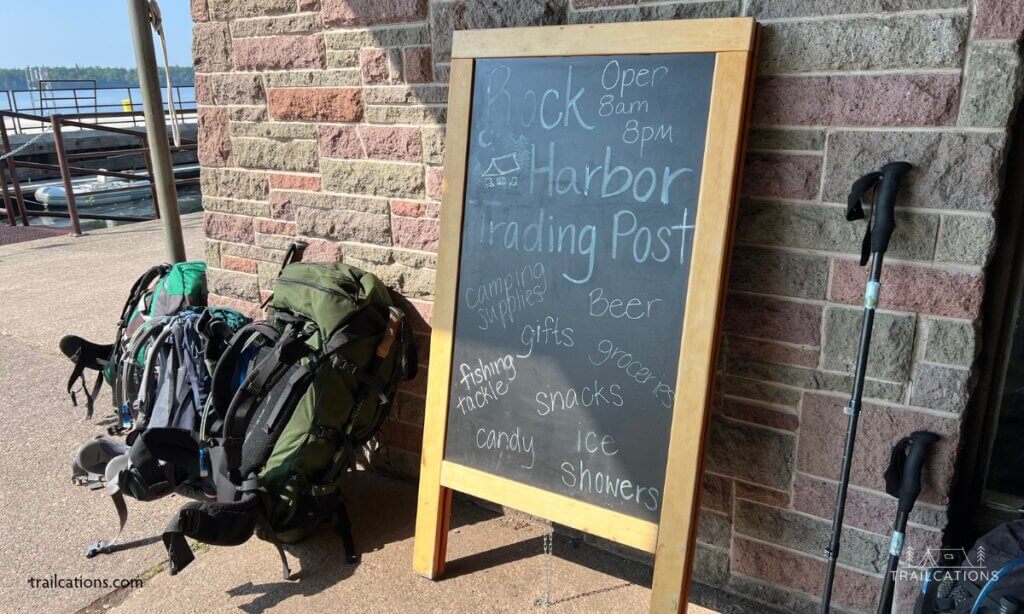
What Happens if I Forget Something on the Mainland?
If you forget something on the mainland, the general stores in Windigo and Rock Harbor have a surprisingly decent amount of supplies for hikers, backpackers, fishermen and visitors alike.
Both stores have camping food, snacks, drinks, beer and wine, insect repellent, bug head nets, toiletries, batteries, camping fuel canisters and white gas, fishing tackle, sun protection, some clothing and limited hiking gear.
However, don’t rely on the stores to be fully stocked, especially if bad weather prevents the supply boats from landing or if it’s later in the season like August and September.
Getting to Isle Royale National Park
Access to Isle Royale is either by ferry boat or seaplane, emphasizing its remote location. Commercial ferry services from both Michigan and Minnesota motor to the island, offering stunning views of Lake Superior and lighthouses.
Ferries and seaplanes mainly dock at Windigo and Rock Harbor but some ferries can drop you off at other locations on the island. There are luggage weight restrictions so make sure to check your transportation operator’s website to avoid having to pay extra or leave gear behind.
Cars are not allowed on Isle Royale. Instead, you leave your car on the mainland and travel across Lake Superior by ferry boat, seaplane or private boat. Ferries are for people only.
How to Get to Isle Royale by Ferry
Here are the lists of ferry operators currently taking visitors from the mainland to and from Isle Royale National Park.
- Ranger III: 6 hours from Houghton, MI to Rock Harbor
- Isle Royale Queen IV: 3.75 hours from Copper Harbor, MI to Rock Harbor
- Sea Hunter III: 1.5 hours from Grand Portage, MN to Windigo
- Voyageur II: 2 hours from Grand Portage, MN to Windigo
- Voyageur II also circumnavigates Isle Royale, leaving Windigo stopping at McCargoe Cove, Belle Isle before stopping overnight at Rock Harbor. The following morning, it leaves Rock Harbor, stopping at Daisy Farm, Chippewa Harbor, Malone Bay and Windigo before returning to Grand Portage, MN.
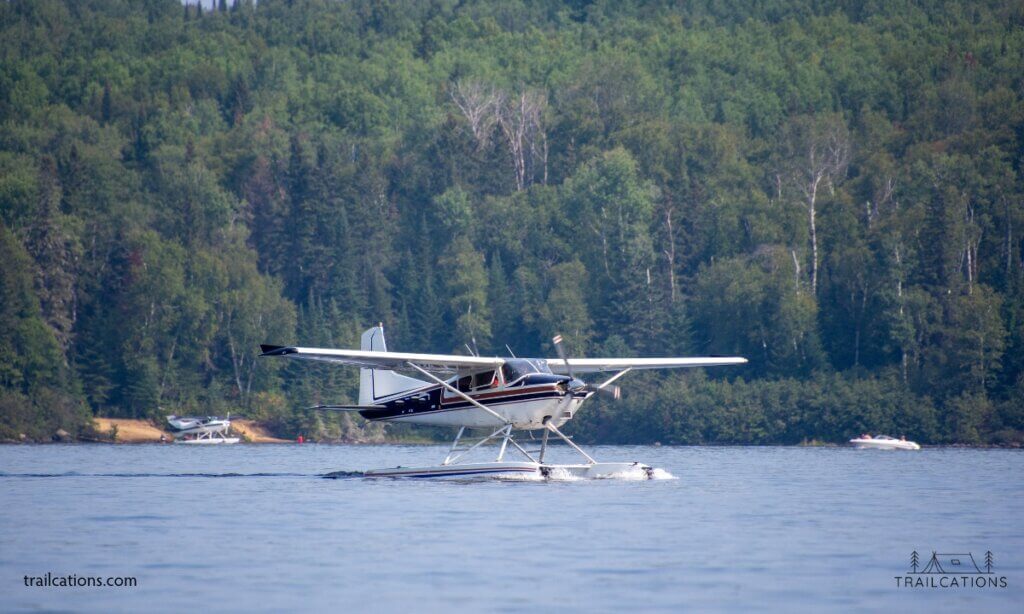
How to Get to Isle Royale by Seaplane
You could also opt for a seaplane if you’re looking for a quicker transit. Seaplanes are excellent options for those wanting to maximize their time on Isle Royale. However, they are more expensive but provide gorgeous birds-eye views of the island.
- Isle Royale Seaplanes: 30-45 min from Hancock, MI to Rock Harbor or Windigo
- Isle Royale Seaplanes: 30-45 min from Grand Marais, MN to Rock Harbor or Windigo
Pro Tip: Arrive to the seaplane and ferries at least 45-60 minutes early, or earlier if specified. It takes time to load your cargo, especially if you’re bringing personal watercraft like canoes or kayaks, perform Coast Guard or FAA safety talks and board the vessel. Remember: the ferries and seaplanes wait for no one!
How to Get to Isle Royale by Private Boat
Private watercraft can access Isle Royale but under certain regulations and with boating permits. Visitors from Canada must clear US Customs at Rock Harbor. Before taking a private boat to Isle Royale, acquaint yourself with the Isle Royale boating rules before embarking on this wilderness adventure.
Don’t Forget to Download Offline Map Apps Before Leaving the Mainland
Since there’s zero cell service or wifi on Isle Royale, download all of your offline navigation apps, podcasts, books, music and more before leaving the mainland.
Bring a power bank to charge your devices and set your phone to airplane mode and low power mode to conserve battery.
Pro Tip: If you’re in a pinch, some electricity outlets can be found at the restaurant in Rock Harbor, and around the Windigo and Rock Harbor bathrooms, showers, laundry room and general store areas.
Pay for Entrance Fees and Permits on the Mainland
Before setting off, make sure you’ve paid the Isle Royale National Park entrance fees and applied for any overnight permits for large groups of 7 or more camping overnight. The Park Service recommends paying for your Daily Entrance Fees online before arriving to Isle Royale.
Isle Royale has gone cashless so if you do need to pay for entrance fees on the island, only credit and debit cards are being accepted.
Overnight camping permits are free for groups of 6 or less. The Park Rangers will help you with permitting either aboard the Ranger III ferry, or after the mandatory 10 minute safety briefing once you’ve arrived at Rock Harbor or Windigo. There’s no need to reserve any permits – it’s currently a very casual process.
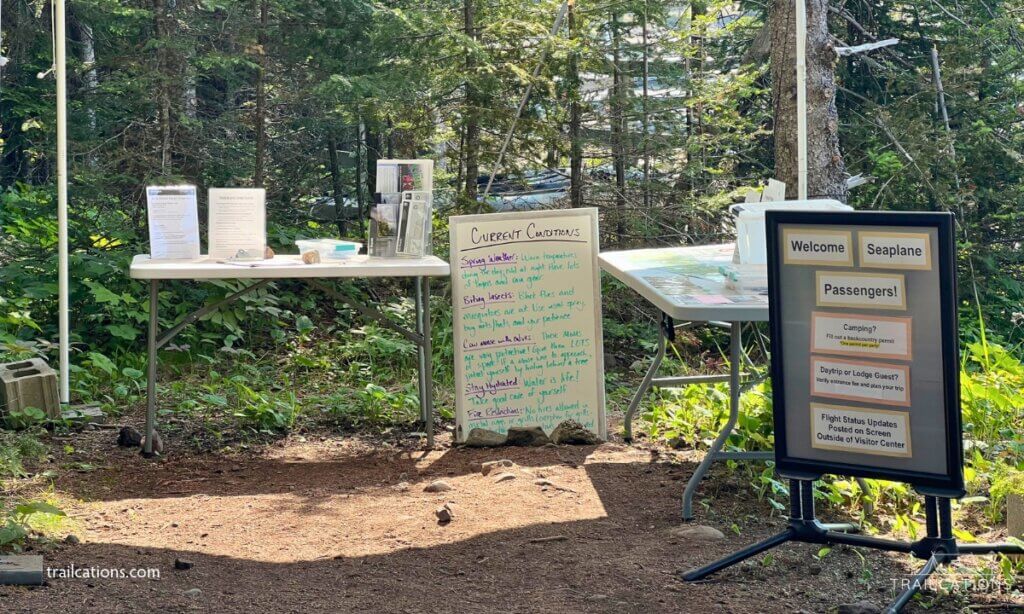
How Much Does it Cost to Backpack Isle Royale?
The main cost of backpacking to Isle Royale is of course your gear and supplies but also the transportation method to reach this remote national park Being located so far from the mainland, cars cannot drive to Isle Royale unlike other national parks. You leave your car on the mainland and take a ferry or seaplane to the park.
Due to limited means of accessing Isle Royale, it can cost a decent amount of money to backpack Isle Royale. It typically costs $160 to $450 per person to backpack Isle Royale for roundtrip transportation alone for a single person. This doesn’t include not to mention daily park fees or group camping permits.
Isle Royale Backpacking Costs
Transportation: $160 to $185 for roundtrip ferry (kids often cost less) OR $360 to $452 for roundtrip seaplane
Entrance Fees: $7 for daily entrance fee per person, $0 for Access, Senior, 4th Grade, Volunteer or Military passholders + up to 3 additional adults
Camping Permits: $0 for overnight permits of groups of 6 or less; $25 to $100 for groups of 7 to 20
What is the Cheapest Way to Backpack Isle Royale?
The cheapest way to backpack Isle Royale National Park is by taking a ferry from either Michigan or Minnesota and hiking in small groups of 6 or less. You’ll still pay at least $160 in transportation fees per person so you’ll have to decide if it’s worth it.
The cost of transportation to Isle Royale National Park is a huge contributor to Isle Royale being one of the least visited National Parks.
Backpacking Isle Royale Maps
When backpacking Isle Royale, you’ll definitely want both a paper map and to have downloaded some offline maps. Remember, there’s limited supplies in the island’s general stores and no cell service or wifi on Isle Royale so make sure you have all your maps with you before departing the mainland!
Best Isle Royale Maps for Planning a Backpacking Trip
When planning our backpacking trips for Isle Royale, the best tools and maps we used were the National Park Service trail map, the NPS backpacking distance mileage chart but most importantly the waterproof National Geographic Isle Royale Map which actually has mileage and topography on it.
We also used trail planning apps like Alltrails and Komoot to get a feel for what the popular trails were and typical hiking conditions. Of course we downloaded the National Park Service app for Isle Royale National Park to find out things to do and have another means to see the park trails.
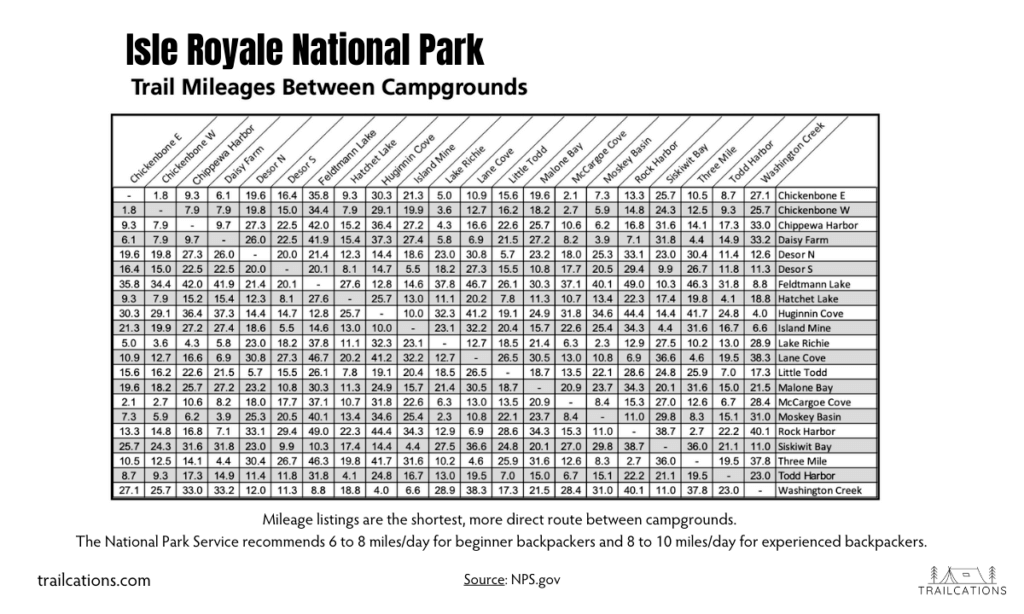
Best Maps for Navigating on Isle Royale While Backpacking
We surprisingly used the National Geographic Isle Royale Map waterproof map quite a lot while backpacking. It’s a bit cumbersome but was very helpful for navigating some of the areas where signage had fallen over or rotted away.
For offline navigation apps, we had downloaded Isle Royale park maps on the Garmin Explore App (free to use – no Garmin device needed), Gaia GPS and the National Park Service app. You could certainly make your own GPX tracks or find them on map apps such as Gaia or Avenza.
Do you like free stuff? We do too! That’s why we compiled a bunch of free Isle Royale National Park maps PDF downloads for you here. You’re welcome 😉
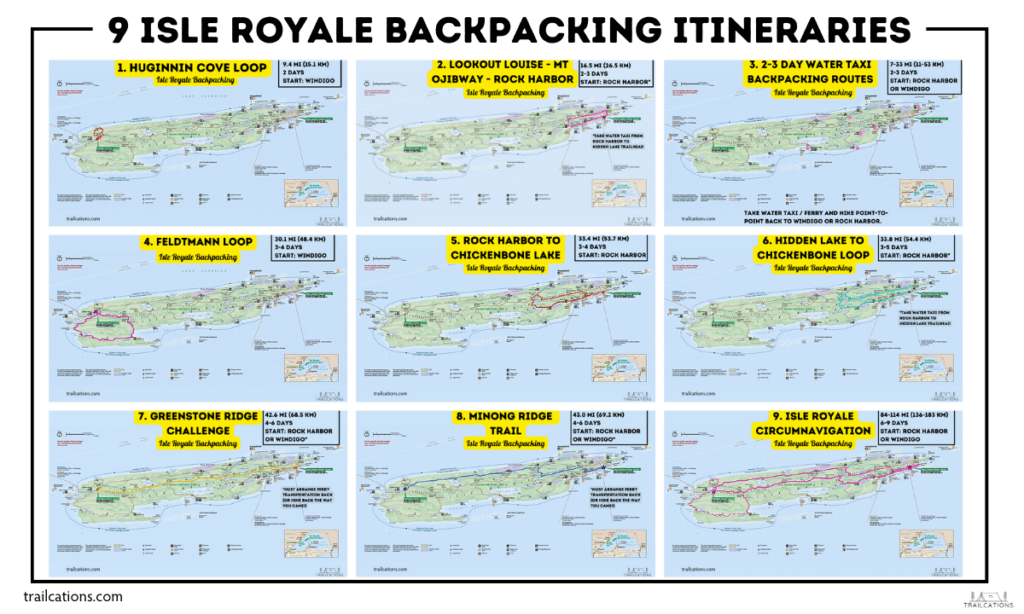
9 Best Isle Royale Backpacking Itineraries
Isle Royale boasts of an intricate trail system, offering 165 miles (265 km) of backpacking trail options depending upon your preference for difficulty and trail length. Most people start their backpacking journeys from Rock Harbor and Windigo, the two main harbors where ferries and seaplanes land.
There are “unofficial” popular backpacking loops throughout the island such as the 8 mile (13 km) Hugininn Cove Loop, the 17 mile (27km) Rock Harbor East Loop or more adventurous 33 mile (53 km) Feldtmann Loop. But for those seeking a more challenging route, consider the Greenstone Ridge Trail which spans over 45 miles (73 km).
For an impressive blend of scenic beauty and trail difficulty, backpacking enthusiasts have a wide variety of options to follow an “unofficial” backpacking route or create their own route. Given the park’s varied terrain, all routes reward hikers with panoramic views and abundant wildlife sightings.
Navigating through these trails requires careful planning utilizing accurate trail maps, especially if you’re new to backpacking. Each route offers unique experiences – it’s all about picking one that aligns with your physical ability and interests.
Here are some ideas for an Isle Royale National Park backpacking itinerary based on how many days you will be on trail.
Isle Royale Backpacking Itinerary Shortlist
- 9 mile (15 km) Hugininn Cove Loop for a quick overnight with beautiful Lake Superior camping
- 17 mile (27 km) Lookout Louise – Mount Ojibway – Rock Harbor Loop for scenic ridge views, coastal hiking and lowland marshes
- 8 to 33 mi (13 to 53 km) Water Taxi Point-to-Point Backpacking Trails are an adventurous variety of 9 different one-way hikes you can take using the water taxi or ferry to drop you off and you hike back to Rock Harbor or Windigo.
- 30 mile (48 km) Feldtmann Loop for secret coves, sweeping vistas and almost-guaranteed moose sightings
- 33 mile (51 km) Rock Harbor to Chickenbone Lake Loop is perfect for experiencing the highlights of the Greenstone Ridge Trail without the hassle of point-to-point logistics.
- 35 mile (57 km) Hidden Lake to Chickenbone Lake Loop for the best views Isle Royale has to offer plus wildlife viewing.
- 45 mile (73 km) Greenstone Ridge Trail (aka Greenstone Challenge) for adventurous backpackers to dive deep into the wilderness and experience a bit of everything Isle Royale has to offer. Not recommended for beginners.
- 49 mile (79 km) Minong Ridge Trail for epic views of Lake Superior, secret beaches, escaping the crowds and rich wildlife.
- 94-115 mile (151-185 km) Isle Royale Circumnavigation to “thru hike” the entire island and experience the wilderness in a way 99% of visitors will never see.
*All distances were calculated using Gaia GPS and the topographical Isle Royale National Park Map by National Geographic. From our experience hiking with GPS, the distance seems to be more accurate on the Nat Geo map vs the NPS mileage charts.
Two Day Isle Royale Backpacking Trip Itineraries

1. Huginnin Cove Loop
Distance: 9.4 miles (15.1 km)
Number of days on trail: 2 days
Trail type: Loop
Trailhead: Windigo
Ideal for: A quick overnight trip with spectacular Lake Superior cliffs, dense forest, old copper mine remains and beachside camping.
Description: This hike is perfect for backpackers short on time or looking to spend their Isle Royale vacation trying a variety of activities such as canoeing, fishing or relaxing. Camp is located on Lake Superior so the mosquitoes aren’t nearly as bad as they are in the island’s interior. Wildlife such as wolves and moose are often spotted on this shorter backpacking trip. Don’t forget to check out the sites of the old Windigo copper mines.
Isle Royale Backpacking Itinerary #1 (9.4 mi / 15.1 km):
- Day 1: Windigo to Huginnin Cove (4.3 mi / 6.9 km)
- Day 2: Huginnin Cove to Windigo (5.1 mi / 8.2 km)
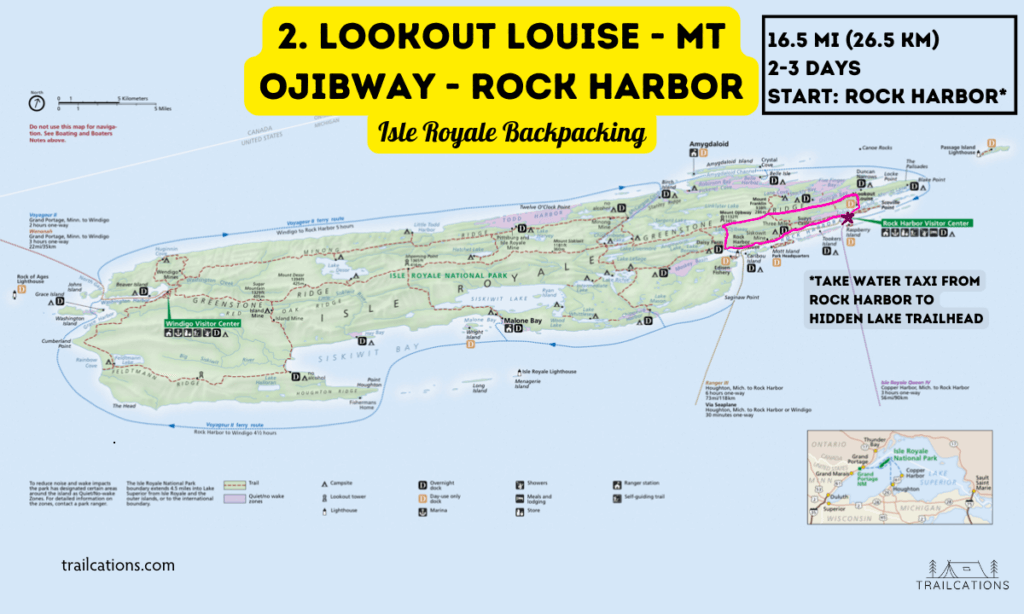
2. Lookout Louise – Mount Ojibway – Rock Harbor
Distance: 16.5 miles (26.5 km)
Number of days on trail: 2-3 days
Trail type: Loop (water taxi + hiking)
Trailhead: Hidden Lake to Rock Harbor
Ideal for: Backpackers short on time looking for the best views on the east side of Isle Royale.
Description: This spectacular 2 to 3 day hike provides some of the best vistas on Isle Royale. If you like overlooks, you’ll be impressed with the stellar 360 degree views of Canada and Minnesota on Lookout Louise to the massive fire tower at Mount Ojibway and the moose viewing on the cliffs of Mount Franklin. Daisy Farm is one of the most beautiful campsites on Isle Royale so plan on staying there at least one night. Don’t forget to book your water taxi at Rock Harbor Lodge to reach Hidden Lake Trailhead!
Isle Royale Backpacking Itinerary #2 (16.5 mi / 26.5 km):
- Day 1: Hidden Lake Trailhead to Daisy Farm (9.6 mi / 15.4 km)
- Day 2: Daisy Farm to Rock Harbor (6.9 mi / 11.1 km)
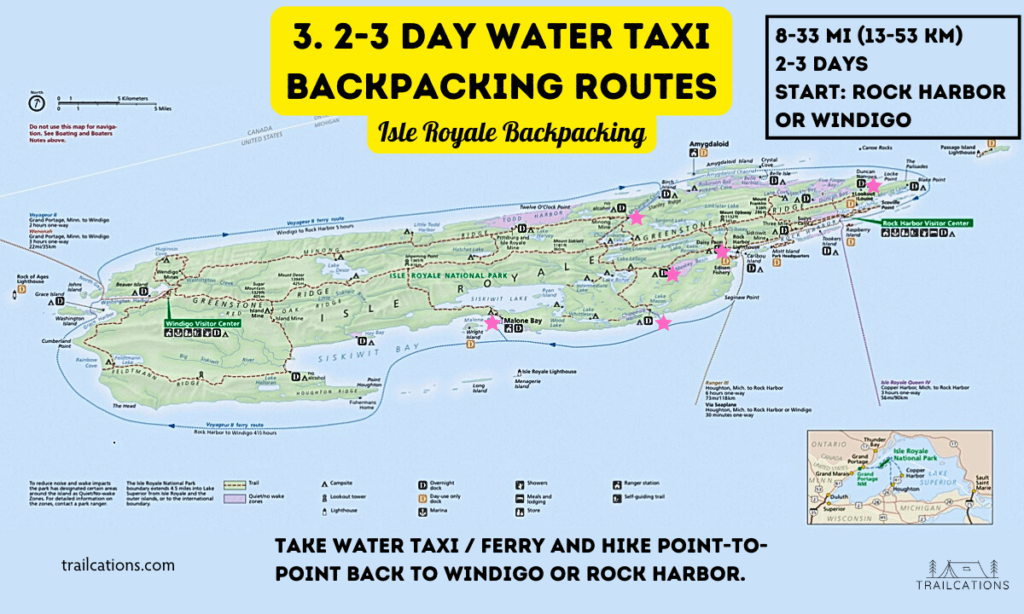
3. Other 2 to 3 Day Backpacking Itinerary Ideas: Water Taxi Point-to-Points
Distance: 7 to 33 miles (11 to 53 km)
Number of days on trail: 2-3 days
Trail type: Point-to-Point (water taxi + hiking)
Trailhead: Various to Rock Harbor or Windigo
Ideal for: Backpackers looking for a bit of “surf and turf” adventure without having to retrace their steps.
Description: Take a water taxi or ferry ride to one of the many docks around the island and hike back to Rock Harbor or Windigo. There are plenty of camping options on the way! Plus it’s a great way to see the barrier islands and lighthouses of Isle Royale.
Rock Harbor Area (water taxi service)
- Daisy Farm to Rock Harbor – 6.9 mi / 11.0 km
- Hidden Lake to Rock Harbor – 10.0 mi / 16.0 km
- Moskey Basin to Rock Harbor – 10.7 mi / 17.1 km
- McCargoe Cove to Rock Harbor – 15.2 mi / 24.3 km
- Chippewa Harbor to Rock Harbor – 16.8 mi / 26.9 km
- Malone Bay to Rock Harbor – 32.6 mi / 52.2 km
Windigo Area (Voyageur II ferry service – must reserve online)
- Malone Bay to Windigo – 21.6 mi / 34.6 km
- McCargoe Cove to Windigo – 27.6mi / 44.2 km
- Chippewa Harbor to Windigo – 33.0 mi / 52.8 km
Three to Four Day Isle Royale Backpacking Trip Itineraries
3 to 4 days backpacking on Isle Royale seems to be the sweet spot. You don’t have to feel hurried like you would with an overnight trip. Plus your chances to spot wildlife increase and you’re able to better enjoy the peaceful forests, lowlands and beautiful beaches.
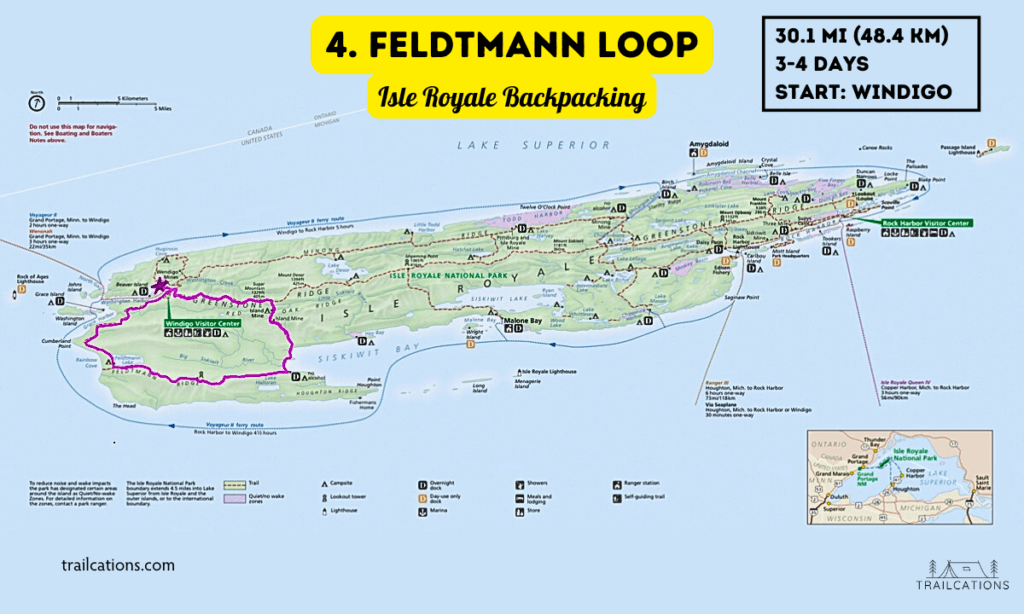
4. Feldtmann Loop
Distance: 30.1 miles (48.4 km)
Number of days on trail: 3 to 4 days
Trail type: Loop
Trailhead: Windigo
Ideal for: Wildlife enthusiasts, photographers and backpackers looking to escape for a few days.
Description: Hidden coves and abundant moose and beautiful views of Lake Superior will reward the intrepid adventurer here. Backpackers who spend a few days hiking the Feldtmann Loop will be rewarded with views, tons of moose, secret Lake Superior beaches and epic fire tower lookouts. Everyone we met who hiked this trail couldn’t stop talking about all the moose they saw and even some wolf sightings. It’s the perfect backpacking trip for photographers, nature lovers and wildlife enthusiasts alike. Bonus: Don’t forget to stop at Rainbow Cove, a hidden Lake Superior beach that is excellent for watching the sunset before heading back to camp.
Isle Royale Backpacking Itinerary #4 (30.1 mi / 48.4 km):
- Day 1: Windigo to Feldtmann Lake (8.5 mi / 13.7 km)
- Day 2: Feldtmann Lake to Siskiwit Bay (10.3 mi / 16.6 km)
- Day 3: Siskiwit Bay to Windigo (11.3 mi / 18.2 km)
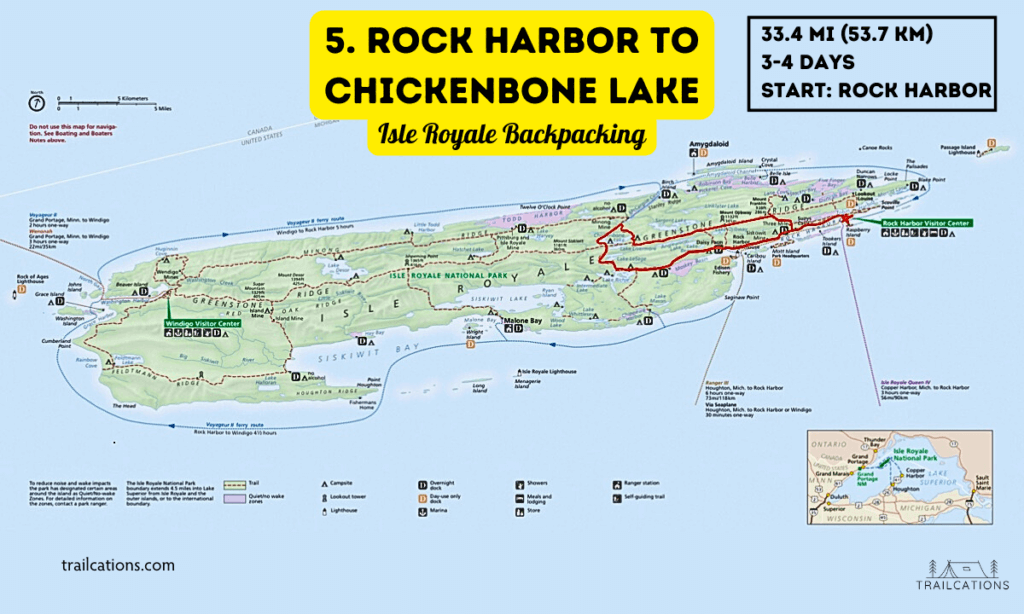
5. Rock Harbor to Chickenbone Lake Loop
Distance: 33.4 miles (53.7 km)
Number of days on trail: 3 to 4 days
Trail type: Lollipop
Trailhead: Rock Harbor
Ideal for: Those looking to spot moose (who love hanging out in the Chickenbone Lake area) and experience the highlights of the Greenstone Ridge without the hassle of point-to-point hike logistics.
Description: This is a condensed version of the Greenstone Ridge Trail that crosses the entire length of Isle Royale but without the complications of arranging point-to-point transportation. You get a little bit of everything with this beautiful Isle Royale Backpacking trip – Suzy’s Cave, Lake Superior waterfront hiking, 360 degree high ridge views, wildflowers, fire towers, swamps and almost guaranteed moose sightings. Be on the lookout around the Chickenbone Lake area for moose – almost every hiker we met out there (including us) saw moose in the area’s lowland lakes, swamps, at camp and on the trails. This Isle Royale National Park backpacking trail has all of the views without all the headache of complicated ferry and seaplane transportation of Greenstone Ridge.
Isle Royale Backpacking Itinerary #5 (33.4 mi / 53.7 km):
- Day 1: Rock Harbor to Daisy Farm (6.9 mi / 11.1 km)
- Day 2: Daisy Farm to West Chickenbone Lake (9.4 mi / 15.1 km)
- Day 3: West Chickenbone Lake to Threemile (14.1 mi / 22.7 km)
- Day 4: Threemile to Rock Harbor (3.0 mi / 5.1 km)
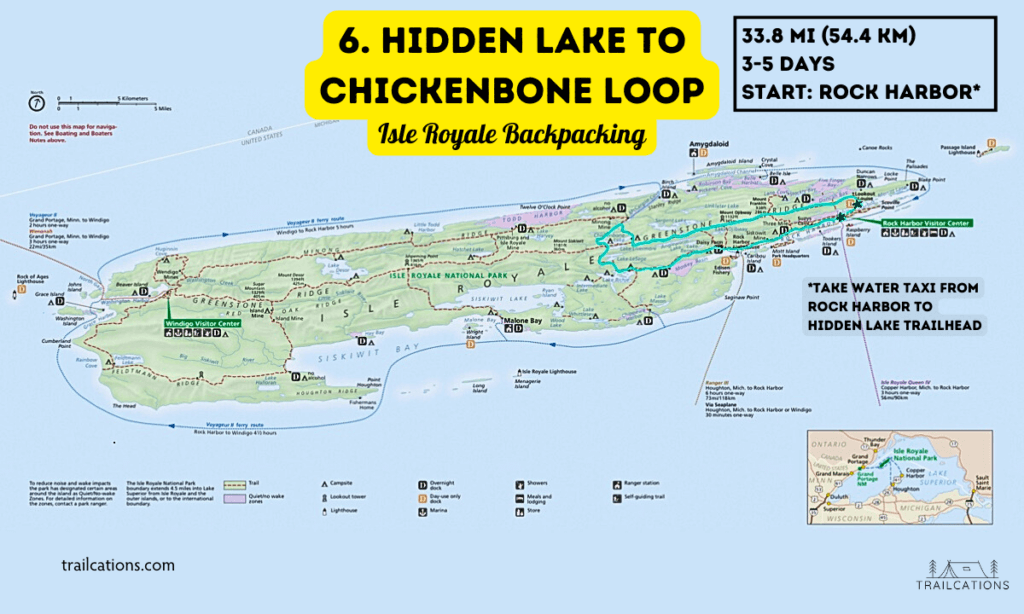
6. Hidden Lake to Chickenbone Lake Loop
Distance: 33.5 miles (53.9 km)
Number of days on trail: 3 to 5 days
Trail type: Loop (water taxi + hike)
Trailhead: Hidden Lake via Rock Harbor
Ideal for: Backpackers and ridge walking enthusiasts who want to see the best views that Isle Royale can offer. The loop around Chickenbone Lake is almost guaranteed for you to spot moose.
Description: This is a beautiful loop trail that accesses the remote eastern side of Isle Royale and all of its ridge walking splendor. Highlights include a water taxi ride to the stunning Lookout Louise, passing fantastic views on Mount Franklin and Mount Ojibway fire tower. Traverse the high Greenstone Ridge with 360 degree views of Canada, Minnesota and the surrounding Isle Royale archipelago. Don’t forget to book your water taxi at Rock Harbor Lodge!
Alternatives to Access Water
Ridge walking on Isle Royale can be very hot and dry during the summer with few if any water sources. So you don’t have to do a 14 mile (23 km) water carry, there are a couple options to split up day 1 to access water and camp.
- Lane Cove Alt: Add 2.1 mi (3.4 km) each way for a total of 4.2 (6.8 km) extra miles by camping at remote yet beautiful Lane Cove on Lake Superior instead of the dry ridge walk to East Chickenbone.
- “Figure 8″ Variation: Add 2.5 mi (4.0 km) to the loop by descending off the dry ridges day 1 and camping at gorgeous Daisy Farm.
Isle Royale Backpacking Itinerary #6 (33.5 mi / 53.9 km):
- Day 1: Rock Harbor to Hidden Lake to East Chickenbone Lake (13.7 mi / 22.0 km)
- Day 2: East Chickenbone Lake to Moskey Basin (9.3 mi / 15.0 km)
- Day 3: Moskey Basin to Threemile (7.5 mi / 12.1 km)
- Day 4: Threemile to Rock Harbor (3.0 mi / 5.1 km)
Lane Cove variation (37.7 mi / 60.7 km)
- Day 1: Rock Harbor to Hidden Lake to Lane Cove (7.5 mi / 12.1 km)
- Day 2: Lane Cove to East Chickenbone Lake (10.4 mi / 16.7 km)
- Day 3: East Chickenbone Lake to Moskey Basin (9.3 mi / 15.1 km)
- Day 4: Moskey Basin to Threemile (7.5 mi / 12.1 km)
- Day 5: Threemile to Rock Harbor (3.0 mi / 5.1 km)
“Figure 8” variation (36.0 mi / 57.9 km)
- Day 1: Rock Harbor to Hidden Lake to Daisy Farm (9.9 mi / 15.9 km)
- Day 2: Daisy Farm to West Chickenbone Lake (9.4 mi / 15.1 km)
- Day 3: West Chickenbone Lake to Daisy Farm (13.7 mi / 22.0 km)
- Day 4: Daisy Farm to Rock Harbor (7.8 mi / 10.9 km)
5 to 7 Day Isle Royale Backpacking Itineraries
For those very adventurous backpackers, ultralighters or recovering thru-hikers, these longer journeys will share with you rarely seen hidden gems that Isle Royale has to offer.
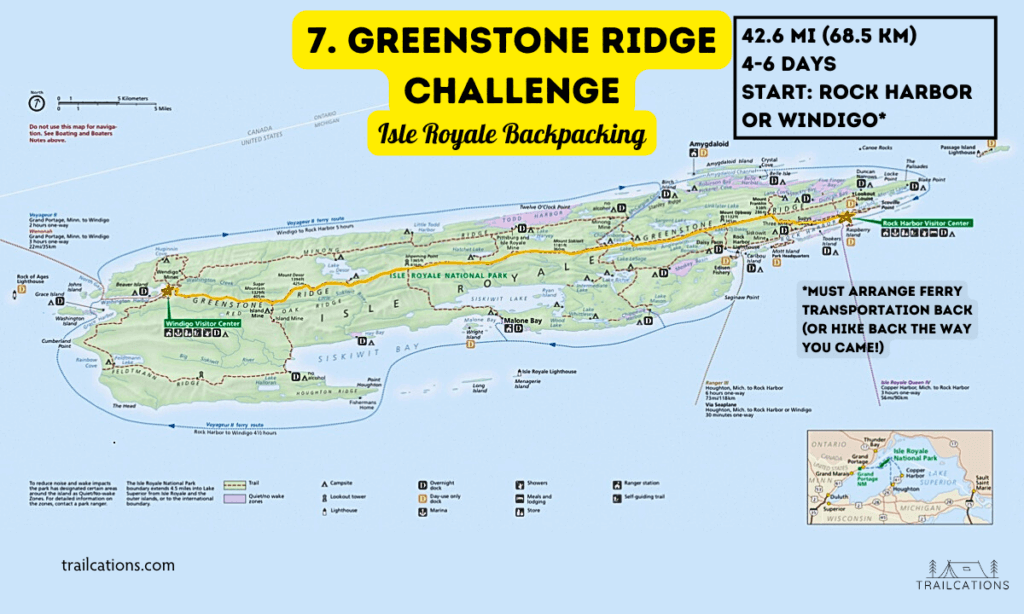
7. Greenstone Ridge Trail
Distance: 42.6 miles (68.5 km)
Number of days on trail: 4 to 6 days
Trail type: Point-to-point (water taxi optional to Hidden Lake Trailhead)
Trailhead: Rock Harbor/Hidden Lake to Windigo (or vice versa)
Ideal for: Adventurous individuals looking to experience the rugged ridges, lowland swamps and wildlife first hand on this challenging backpack trip. You’ll need to figure out transportation back to your starting point which can add complexity to trip planning.
Description: If you’re in need of an adrenaline rush or just searching for a thrilling backpacking adventure, then don’t miss out on The Greenstone Challenge. It’s an initiative by park rangers that encourages visitors to explore nature by hiking all 43 miles (69 km) of the trail. This unique experience will give you a comprehensive taste of the wonders Isle Royale National Park holds.
Unless you plan on hiking another 43 miles (69 km) back to Windigo or Rock Harbor once finished, make sure to plan carefully how you’ll return back via one of the ferries or seaplanes. Don’t forget to book your water taxi at Rock Harbor Lodge if you’re going to start at Hidden Lake Trailhead which is only accessible by boat.
Isle Royale Backpacking Itinerary #7 (42.6 mi / 68.5 km):
- Day 1: Rock Harbor to Hidden Lake to Daisy Farm (9.7 mi / 15.6 km)
- Day 2: Daisy Farm to West Chickenbone Lake (7.9 mi / 12.7 km)
- Day 3: West Chickenbone Lake to Hatchet Lake (7.6 mi / 12.2 km)
- Day 4: Hatchet Lake to South Lake Desor (8.1 mi / 13.0 km)
- Day 5: South Lake Desor to Windigo (12.0 mi / 19.3 km)
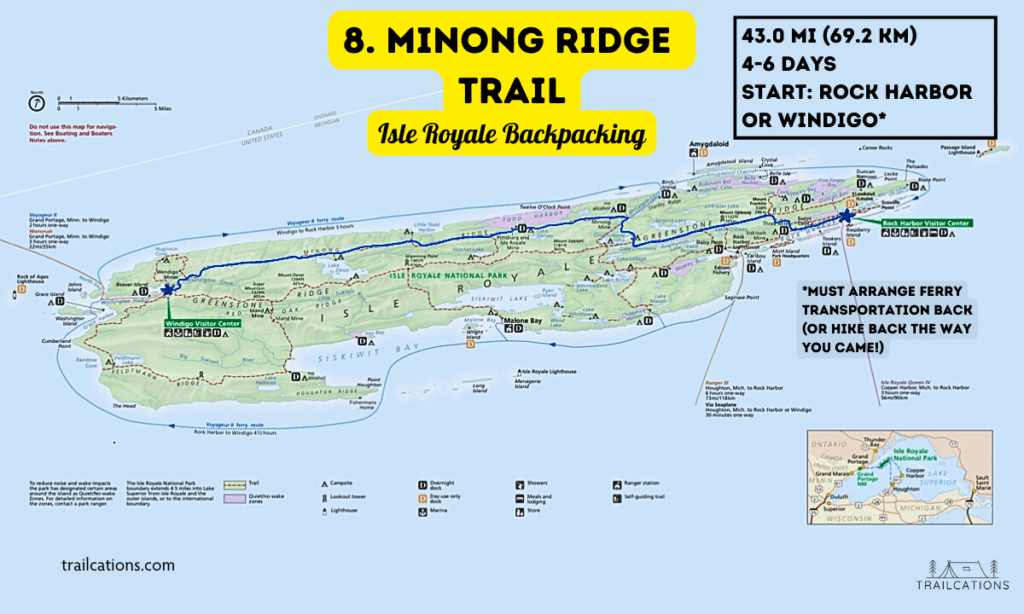
8. Minong Ridge Trail
Distance: 43.0 miles (69.2 km)
Number of days on trail: 5 to 6 days
Trail type: Point-to-Point
Trailhead: Windigo or Rock Harbor
Ideal for: Anyone looking to escape the crowds on Greenstone Ridge and take in better views and more beaches.
Description: Minong Ridge is not for the faint of heart with its hot dry ridges and long swampy boardwalks. However, in our opinion it’s much more scenic and less traveled than the popular Greenstone Ridge, making it a great place to spot wildlife and enjoy the peace of the wilderness. You have the option to escape the hot, mosquito and leech-filled interior lakes and enjoy lunches and dinners on Lake Superior’s spectacular beaches. Make sure to arrange your travel back to where you started from our you might just be walking back the walk you came!
Isle Royale Backpacking Itinerary #8 (43.0 mi / 69.2 km):
- Day 1: Windigo to North Lake Desor (11.3 mi / 20.8 km)
- Day 2: North Lake Desor to Todd Harbor (10.3 mi / 16.6 km)
- Day 3: Todd Harbor to East Chickenbone Lake (9.0 mi / 14.5 km)
- Day 4: East Chickenbone Lake to Threemile (8.1 mi / 13.1 km)
- Day 5: Threemile to Rock Harbor (3.0 mi / 5.1 km)
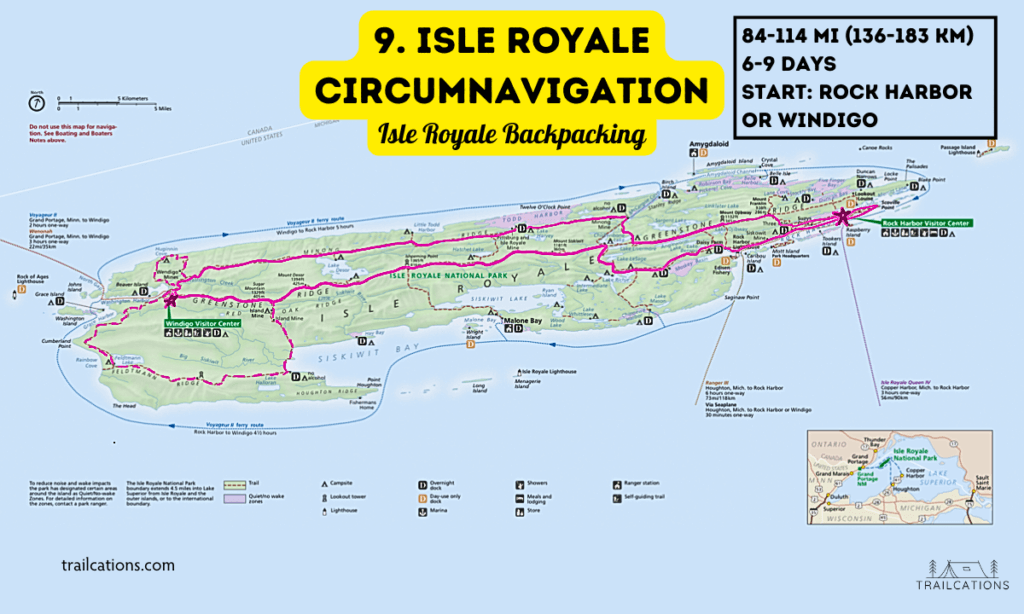
9. Isle Royale Circumnavigation
Distance: 84 to 114 miles (136 to 183 km)
Number of days on trail: 6 to 9 days
Trail type: Loop
Trailhead: Rock Harbor or Windigo
Ideal for: Expert backpackers only. This is the closest option to “thru-hiking” Isle Royale National Park. The circumnavigation is no small feat and is truly a magnificent trip filled with all the beauty the island has to offer, plus rarely explored hidden gems.
Description: If you’re a backpacking junkie, ultralight backpacker, a recovering or current thru-hiker, this is the Isle Royale adventure for you. Circumnavigating allows you to travel Isle Royale’s wilderness in all its splendor, from the two-country 360 degree views on Minong and Greenstone ridges, to moose-filled lowland lakes and remote agate laced beaches on Lake Superior. Plus, halfway through your epic trek you can stop at Windigo or Rock Harbor for a cold beverage and a bite to eat. What’s not to love?
Isle Royale Backpacking Itinerary #9 (84 mi / 136 km):
- Day 1: Windigo to North Lake Desor (11.3 mi / 18.2 km)
- Day 2: North Lake Desor to Todd Harbor (10.3 mi / 16.6 km)
- Day 3: Todd Harbor to Threemile (18.4 mi / 29.6 km)
- Day 4: Threemile to Rock Harbor to Moskey Bay (15.3 mi / 24.6 km)
- Day 5: Moskey Bay to Hatchet Lake (12.6 mi / 20.3 km)
- Day 6: Hatchet Lake to South Lake Desor (7.2 mi / 11.6 km)
- Day 7: South Lake Desor to Windigo (11.2 mi / 18.0 km)
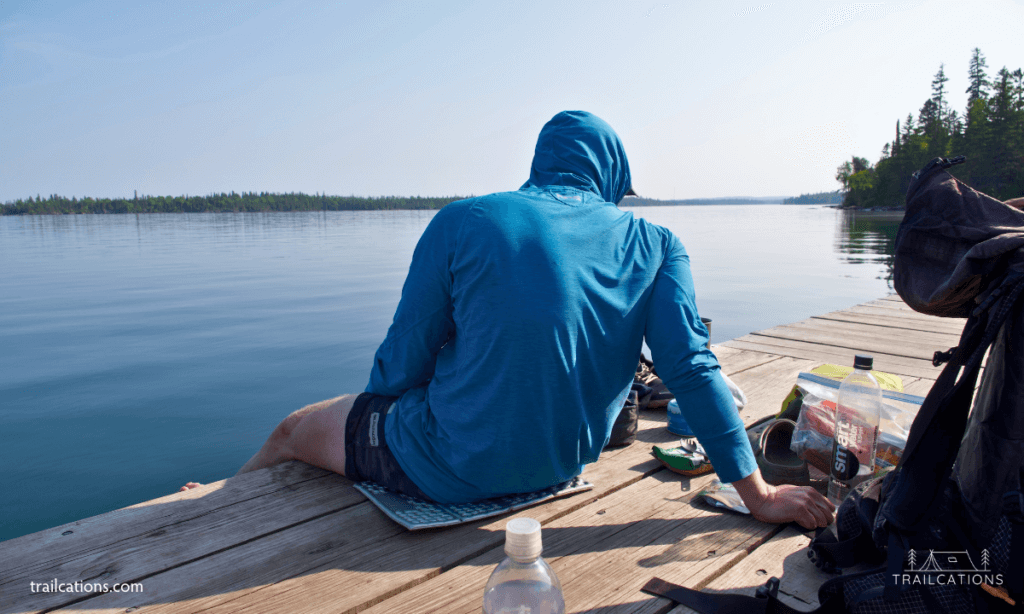
Arriving at Camp and Campsite Etiquette
All of the campgrounds on Isle Royale are first-come, first-serve. Some have large group sites; some are only a couple of small sites tucked away on a remote hillside. A few of the more popular campgrounds have amenities like fire pits, picnic tables or screened-in four sided shelters that are also first-come, first-serve.
A campsite map will be waiting for you at the entrance trail to the campground. Be aware that during busy times you may have to share a campsite, head to the overflow site or pitch a tent outside a shelter.
How to Select a Campsite on Isle Royale
- Once at the campground, select a campsite or shelter and attach your permit to the tent, shelter door or marker post.
- When all sites are occupied, use the overflow group campsite if available.
- When all sites are occupied, ask to share a tent site.
- When all sites are occupied and there are no viable tent sites to share, ask to set up your tent or hammock outside of a shelter.
- When options 1 – 4 are full, you are allowed to camp outside of the campground per the cross-country camping regulations and camping zone map.
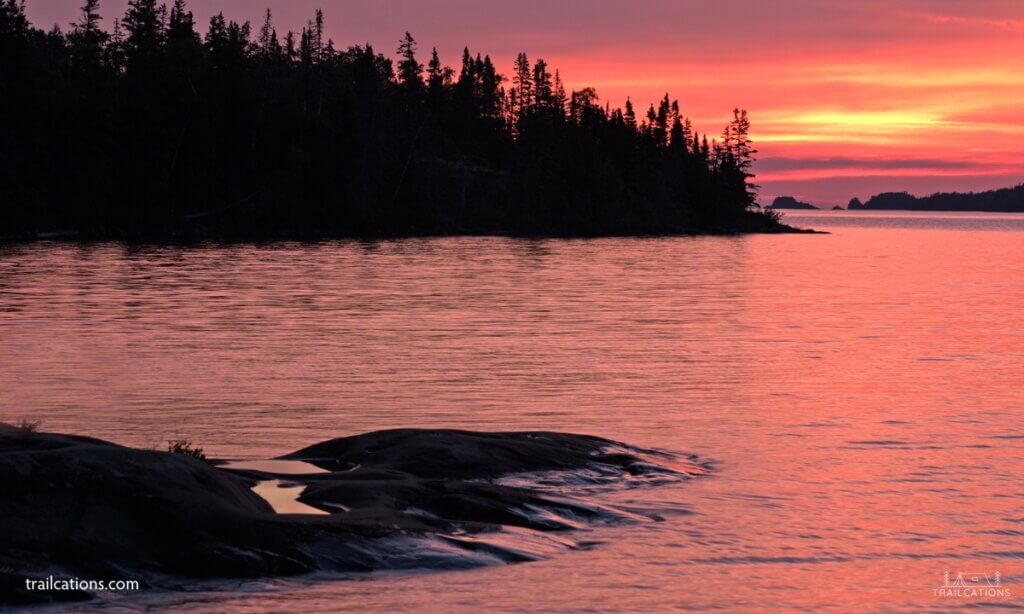
Is Dispersed Camping Allowed on Isle Royale?
Typically, dispersed camping is not allowed on Isle Royale. There are usually plenty of established campsites available at the 36 campgrounds on the island.
However, if it’s the busy season and there are no viable tent sites or sites outside a shelter, you are allowed to disperse camp per the Isle Royale cross-country camping regulations map.
Is it Safe to Camp on Isle Royale?
Yes, it is absolutely safe to camp on Isle Royale. As long as you keep a clean campsite, store your food properly and dispose of trash following Leave No Trace principles, you shouldn’t have to worry about a whole lot.
Since 99% of Isle Royale is a federal wilderness, you may spot wildlife near or in camp. We did have a friend have a moose sniff his tent at Windigo’s Washington Creek Campground. Wolves, foxes or rodents may be attracted to a dirty campsite, one where food was burned in the fire pit or if you don’t hang your food from a tree.
Because Isle Royale is difficult to reach, and the backcountry campgrounds are even harder to access, it deters a lot of “riffraff,” people partying or doing sketchy things you’d see at front country campgrounds on the mainland. You shouldn’t have to worry about other people, except maybe silly day hikers near the main harbors.
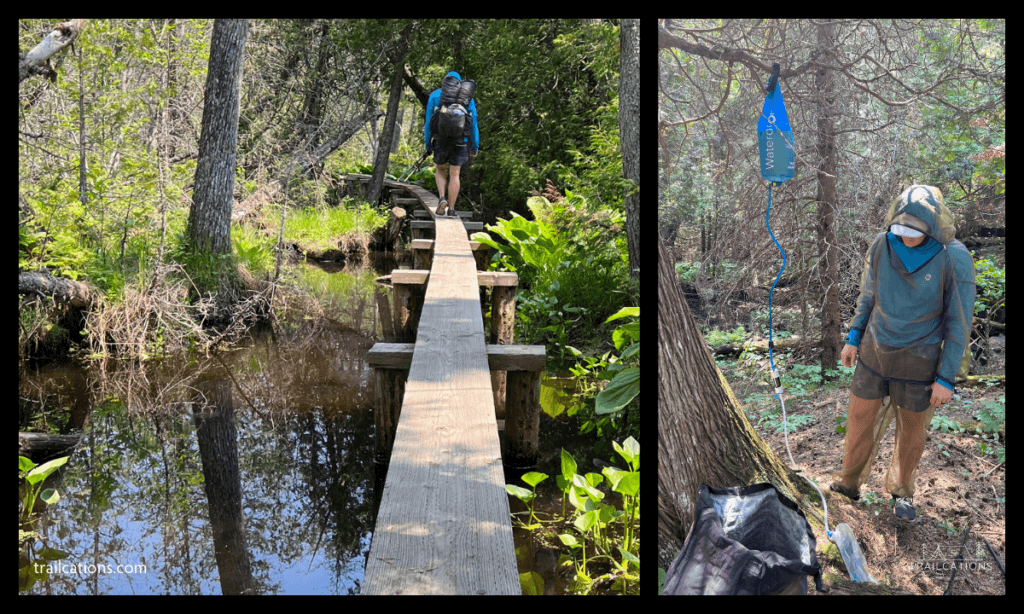
Water Sources and Food Storage Tips
Water is readily available from Lake Superior or inland lakes but must be treated or boiled before consumption. For this, bring along a reliable water filter or purifier. The water purification method must be able to kill tapeworm eggs which are prevalent on Isle Royale – not all backcountry water treatment methods can do this.
Each of Isle Royale’s 36 campsites have a nearby backcountry water source. Water sources on the trails tend to be in the lowlands.
The ridges are extremely hot and dry and it can be 10 miles (16 km) or more water carries.
Make sure you have at least a 2 to 3 liter water capacity or more, especially in hot weather. Dehydration is more common than you would think on Isle Royale.
Algal Blooms in Isle Royale’s Water Sources
In July and August, the inland lakes make experience a blue-green algae bloom which is deadly poisonous to drink. Backcountry water purification methods CANNOT make algal bloom water toxins safe – in fact, they actually concentrate the toxins.
Check algal bloom conditions both online and upon arriving to Windigo and Rock Harbor. Take a moment to familiarize yourself with what an algal bloom looks like. When in doubt, do not drink the water and move on.
Food Storage on Isle Royale
Food storage is crucial on Isle Royale, primarily to avoid attracting wildlife such as sneaky foxes, mice and red squirrels, all of which almost stole our food at camp at different times when we left it unattended for several minutes. Hang your food and scented items from a tree to avoid rodents chewing through your tent or pack.
Always maintain cleanliness in your camp area to protect both you and the island’s wildlife. Don’t burn food wrappers, containers or scraps as it attracts wildlife. You don’t want to give animals like wolves a reason to come visit.
If you’re going fishing, fish remains should be disposed of in water 50 ft (15 m) deep or in water sources 200 ft (61 m) away from camp, water sources and trails.
Remember that food and trash left unattended could attract animals, leading to unfortunate encounters.
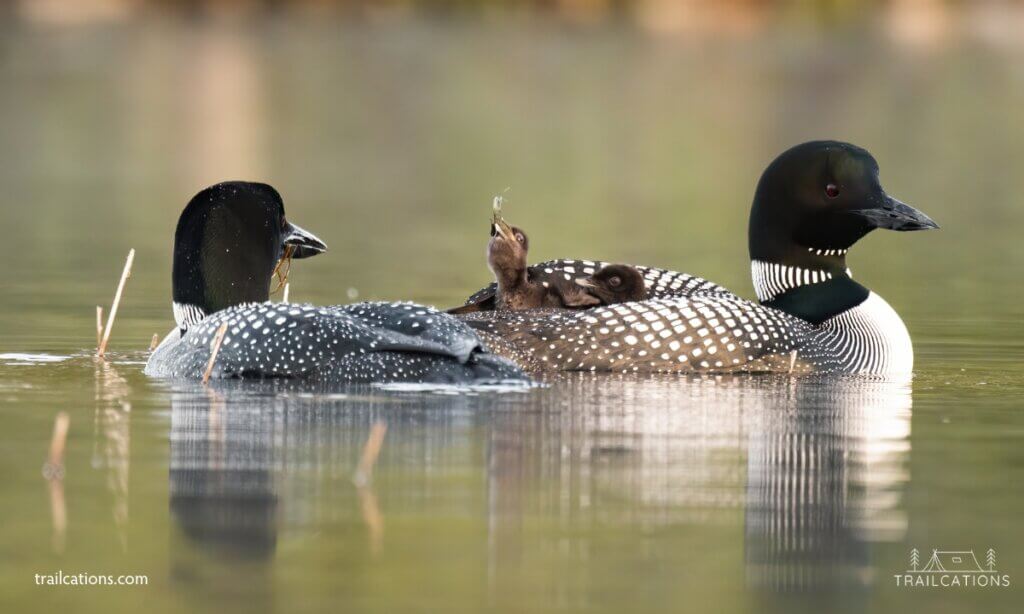
Wildlife Watching on the Island
A highlight of your Isle Royale adventure will surely be encountering the abundant wildlife. The hiking and backpacking trails of Isle Royale are actually some of the best places to view wildlife like moose, wolves, beavers, foxes and loons!
Take caution when spotting a moose or any other wildlife and admire from a safe distance. Especially in the spring, moose mothers can be very aggressive and in the fall rut season males are very territorial.
Remember, this is their home; we’re just visitors.
Birdwatchers will also love Isle Royale. Migratory species like hawks, eagles, waterfowl and loons are common sights – making it perfect for some avian photography.
To learn more about the island’s wildlife, check out our Isle Royale Wildlife Spotting Tips. With its unique protected animals, Isle Royale is also a fantastic place for wildlife photography.
Animal Safety While Backpacking Isle Royale
There are no venomous animals on the island, however there are a few animals to be aware of to have a safe and fun backpacking trip on Isle Royale National Park.
Moose on Isle Royale
Moose range in numbers from 400 to 2,400 individuals on Isle Royale at any one time so there’s a good chance you’ll see at least one while backpacking, especially in the swampy lowlands. Give these aggressive 1,000-2,000 lb (450-900 kg) animals at least 75 ft (23 m) of space.
Moose cannot see very well so if one charges you, hide behind a tree, rock, bush and don’t move. You CANNOT outrun a moose.
Mama moose with calves in the spring and summer can be very aggressive; same with bulls in rut during the fall season. Many people we’ve met actually fear moose more than bears due to their quick to aggression behaviors.
Wolf Encounters While Backpacking on Isle Royale
Wolves typically are elusive but you should avoid attracting them to camp by not burning trash and storing food properly. If you come across a moose or animal carcass, immediately leave the area as wolves are likely nearby.
If you encounter a wolf at close range (less than 25 ft or 7 m) and it doesn’t leave or is coming closer, do whatever you can to end the encounter. Back away and make noise but do NOT run. If you see one more than 25 ft (7 m) away, leave the area immediately and do NOT run.
One of the park rangers we met had been solo hiking recently when a wolf approached her. It wouldn’t leave, even when she yelled at it and she slowly backed away. She threw her water bottle at the wolf, almost hitting it and only then it left her alone.
Mosquitoes and Biting Flies May Just End Your Backpacking Trip
Mosquitoes and biting black flies, horse flies and deer flies can be absolutely horrendous on Isle Royale at certain times of the year. Bring the strongest bug spray you can find (ex: 100% DEET, 20% or more Picardin) and a bug head net or bug suit. Consider spraying all of your gear with permethrin before leaving to deter mosquitoes and biting flies.
Do not underestimate the Isle Royale mosquitoes and flies! Even hike-running a quick 4 mph (6.5 kph), mosquitoes were constantly swarming us in huge bloodsucking clouds. At sunset it was even worse and the mosquitoes were as bad as the ones in the Florida Everglades (aka INSANE). My sun shirt is now permanently stained with dozens of blood spots after Isle Royale’s mosquitoes.
Pro Tip: The mosquitoes are less bad at the campsites on Lake Superior vs. the interior lakes due to the cooler temperatures and breezes. Opt for Lake Superior camping whenever you can.
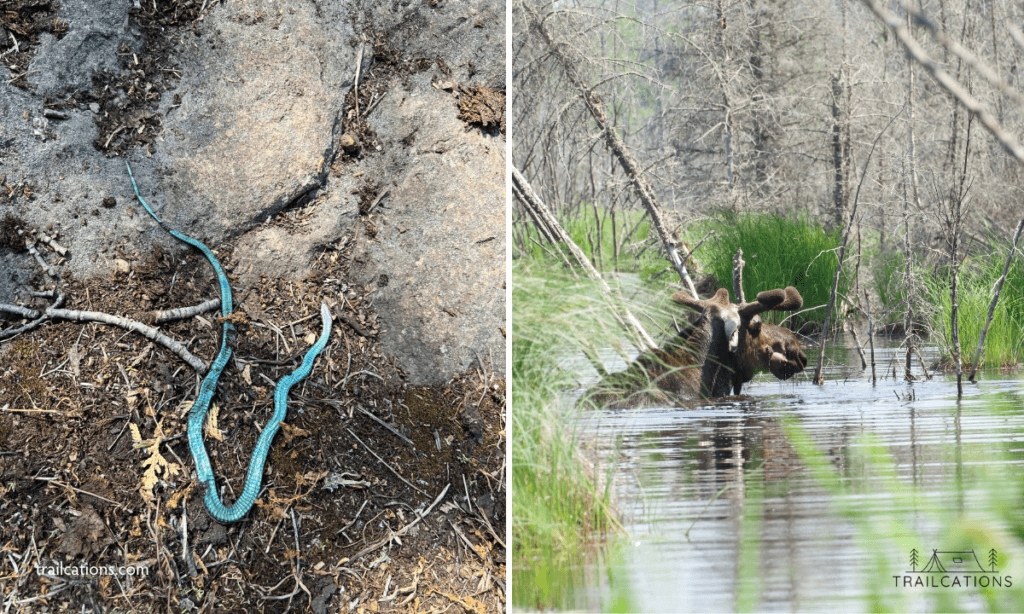
Snakes on Isle Royale
Snakes are surprisingly abundant on Isle Royale, especially in the summer on the hot dry Greenstone Ridge and Minong Ridge. In fact, we spotted 20 to 30 garter snakes last time we backpacked Isle Royale.
Luckily there are no venomous snakes on Isle Royale.
Other Isle Royale Wildlife
There are no Lyme disease carrying deer ticks or chiggers on Isle Royale. Dog ticks are rarely seen on Isle Royale and they do not carry Lyme disease.
There are no bears, coyotes, mountain lions or other big predators currently present on Isle Royale besides wolves.
However, you may be surprised to see how huge animals like toads and frogs get on Isle Royale due to the absolute feast of insects available. I almost peed my pants when an absolutely massive toad rolled down the hill at me on the Minong Ridge. I swear that thing was the size and weight of 2 soup cans!
Also, I just learned about “moose ticks” which because of climate change have formed swarms so numerous they are overwhelming and killing off moose on Isle Royale. Moose ticks don’t affect humans which is nice. However, I sure am glad I didn’t know about this before going to Isle Royale last time. Learn more about the swarms of Isle Royale moose ticks horror story here.
Leave No Trace Principles at Isle Royale
When exploring Isle Royale National Park, adhere strictly to “Leave No Trace” principles – these are guidelines designed to ensure minimal impact on the surrounding environment.
These include respecting wildlife by observing from a distance, packing out waste (including biodegradable items), and not disturbing natural formations or plant life.
The principle extends to campsites – ensure they’re clean before you depart. By following these guidelines, you’ll contribute to the preservation of Isle Royale’s unique ecosystem.
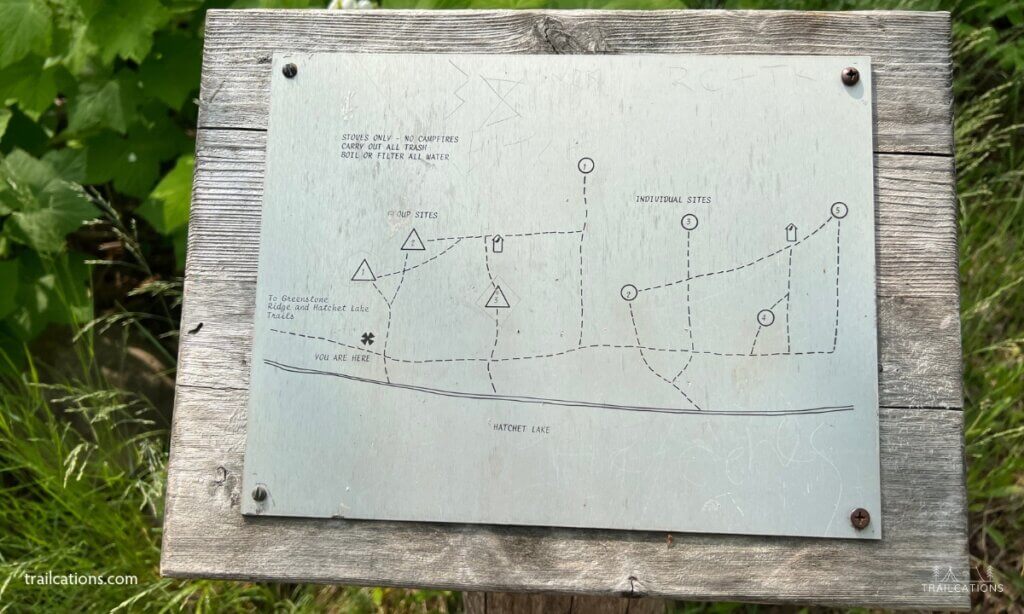
Isle Royale Overnight Camping Permit Process and Fees
Before you head out on your Isle Royale backpacking adventure, familiarize yourself with the necessary permit and entrance fees processes.
Backcountry Permits for Backpacking Isle Royale
Everyone must have a backcountry permit if they’re camping overnight on Isle Royale. Permits are required regardless of group size for any overnight stay at campgrounds across the island. Day hikers do not need backcountry permits.
Backpacking Permits for Large Groups (7 to 20 people)
If you’re backpacking and camping overnight with a group of 7 or more, you must reserve and pay for any Group Camping overnight permits before arriving on Isle Royale. If you don’t reserve your large group permit ahead of time, you will be asked to leave the island immediately and potentially fined.
Backpacking Permits for Small Groups (1 to 6 people)
Overnight camping permits are free for groups of 6 or less. The Park Rangers will help you with permitting either aboard the Ranger III ferry, or after the mandatory 10 minute safety briefing once you’ve arrived at Rock Harbor or Windigo. There’s no need to reserve any permits – it’s currently a very casual process.
Entrance Fees
However, there is an entrance fee to access the park – $7 per person per day. Alternatively, you can purchase an annual pass for $60 or use a Military, Access, Senior, Volunteer, Annual or 4th Grade National Park Pass. Entrance fees can be paid online or from Isle Royale park offices or visitors centers (credit and debit card ONLY on Isle Royale).
Isle Royale has gone cashless so if you do need to pay for entrance fees on the island, only credit and debit cards are being accepted.
Trailcations Isle Royale camping guide provides comprehensive information on fees and permits which might be useful for your planning.
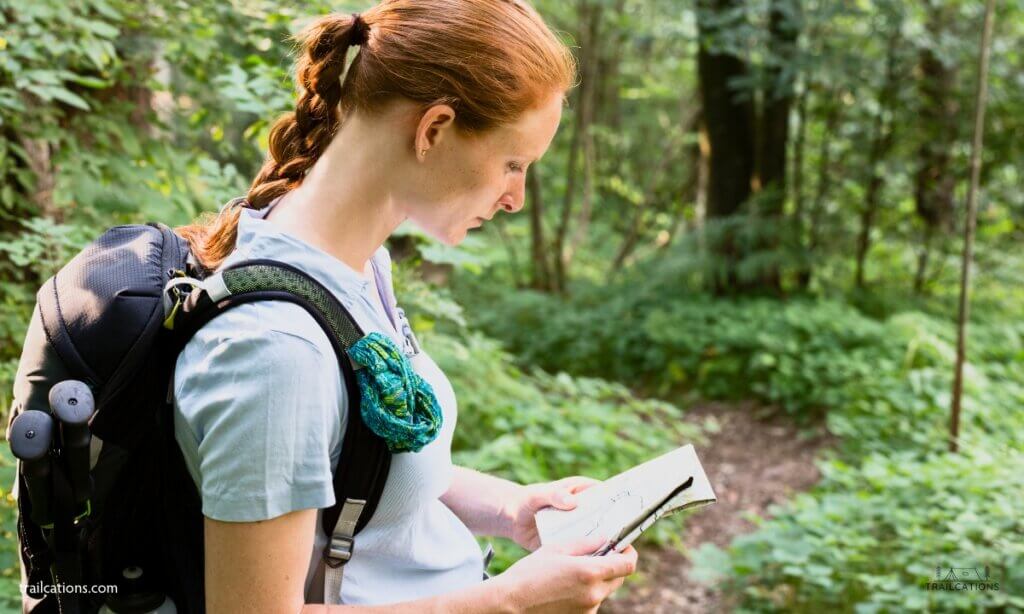
Staying Safe While Backpacking in Remote Wilderness
While Isle Royale offers an exciting wilderness trekking experience, remember it’s critical to prioritize safety. Keep equipped with a sturdy pair of hiking shoes, a Personal Locator Beacon and a first aid kit that comes handy in case of injuries or blisters.
The terrain on Isle Royale is fairly challenging with rocks, roots, mud and flooded trails from beaver dams. Hiking poles are highly recommended, especially for the steep ridges, sandy hills and muddy lowlands.
Importance of Self-Reliance on Isle Royale
The Park Rangers stress how important it is to be self-reliant in the backcountry as rescues can take many hours to several days due to the remote nature of the area and lack of resources. As there is no cell service or wifi, it is a very good idea to bring a Personal Locator Beacon or satellite messenger in case of emergency.
Also, check out the latest conditions on Isle Royale to stay informed about the potential hazards. Knowing what to do when confronted with wildlife or navigating challenging terrain will make your journey safer and more enjoyable.
Dehydration Hazards
Even though Isle Royale is located in cool, remote Lake Superior with lots of trees and lake breezes, dehydration is a real hazard when backpacking. If you’re going to be hiking on any of the ridges, keep in mind that the dark greenstone rock underfoot radiates heat. It can be quite hot and dry, with few water sources and long water carries of 10 miles (16 km) or more.
Know the signs of dehydration and pack electrolytes to replenish salts lost to sweating.
Leave Your Itinerary with a Trusted Contact AND Park Rangers
Lastly, ensure someone knows about your itinerary and expected return time – it’s always good to have someone back home aware of your whereabouts when venturing into remote locations.
Park Rangers keep a copy of your backcountry permit with your itinerary. Upon leaving, they ask you to submit your permits back to them at the Windigo and Rock Harbor Visitor Centers after you’ve completed your hiking trip to keep tabs on who is still on island.
Enjoy your trip, but never neglect your safety.
FAQs
What is the best time of year to backpack on Isle Royale?
June, July, August and September are often recommended as the best time of year to backpack Isle Royale. These months have pleasant temperatures and backpacking conditions.
Transportation services to the island such as ferries and seaplanes are running regularly during this time. Amenities such as the restaurants in Rock Harbor are open and the general stores tend to be well stocked.
The snow, mud and ice are typically gone by June and don’t form again until October.
How do I get to Isle Royale National Park?
Isle Royale is only accessible by boat or seaplane. You leave your car on the mainland – there are no roads on Isle Royale and wheeled vehicles are forbidden. Isle Royale is a remote island located in Lake Superior 14 mi (22 km) from the nearest mainland. There are no other ways to access Isle Royale except by ferry, seaplane or private boat.
Reserve your transportation to and from Isle Royale at least 1-3 months in advance, especially due to limited capacity on the ferry and seaplane. During the busy months of July and August, the Isle Royale ferry and seaplanes often sell out several months in advance.
What kind of trails can I expect on Isle Royale?
The island offers a wide range of trails, from easy 4-mile round trips like the Rock Harbor Trail to Suzy’s Cave, to challenging multi-day treks such as the 45-mile (73 km) long Greenstone Ridge Trail.
Trails vary in difficulty and length, providing options for all skill levels. Isle Royale trails are typically rugged, filled with rocks, roots and single board walks over swamps.
Are there campgrounds available on Isle Royale?
Yes, there are 36 campgrounds across the island, each with tent sites and a water source.
They are only accessible by foot or watercraft.
Can beginners enjoy backpacking on Isle Royale?
Yes, the park offers trails and trips suitable for beginners. Options exist for bringing children along as well.
All trails are well marked and maintained, ensuring a fairly low-stress hiking experience.
Do I need a guide to hike on Isle Royale?
While not required, many guided services offer planned or custom itineraries catering to all points on the island.
A guided tour can be helpful, particularly for those new to wilderness travel or remote locations.
Can you bring firearms to Isle Royale National Park?
Yes, you can bring firearms to Isle Royale National Park. Since February 22, 2010, a federal law has allowed people who can legally possess firearms under applicable federal, state, and local laws to possess them in the park. However, there are restrictions and regulations, such as the requirement for a Michigan approved concealed weapons permit.
For visitors taking the Ranger III ferry, public boats or seaplanes to the island, you’ll have to get prior approval from the ferry or seaplane captain and place the weapon unloaded in locked storage for the duration of the trip. Firearms are also not permitted in certain buildings on Isle Royale. It’s important to be familiar with and follow all applicable state, local, and federal gun laws when bringing firearms to the park.